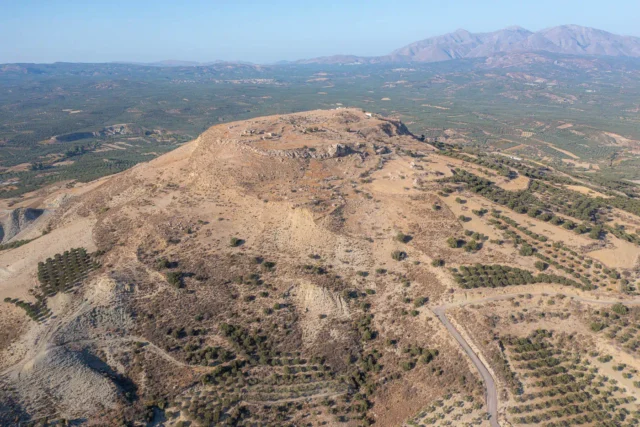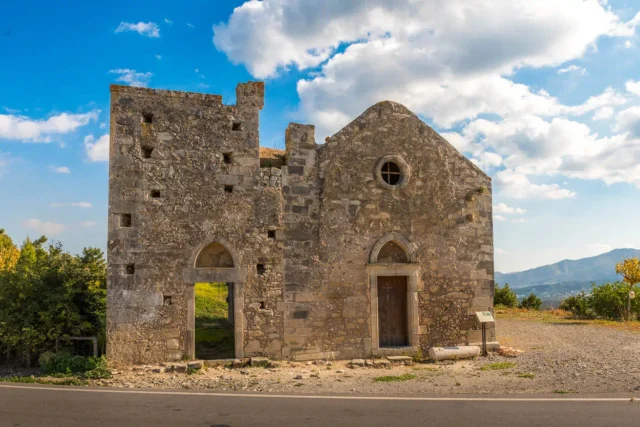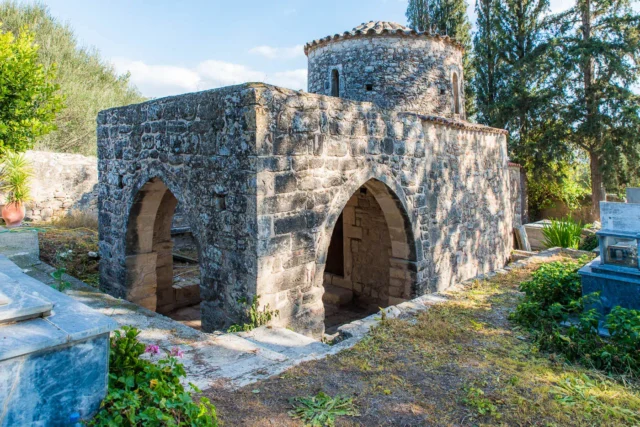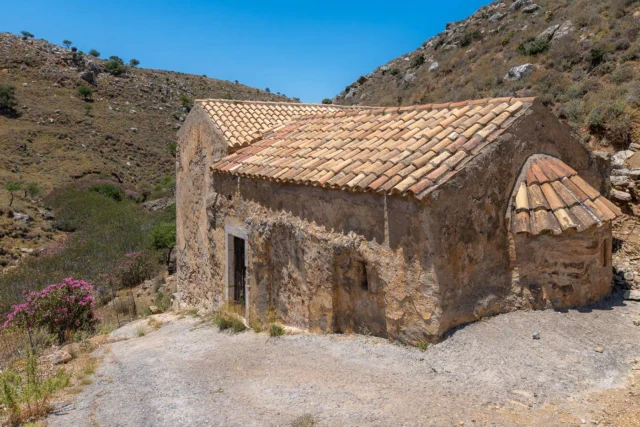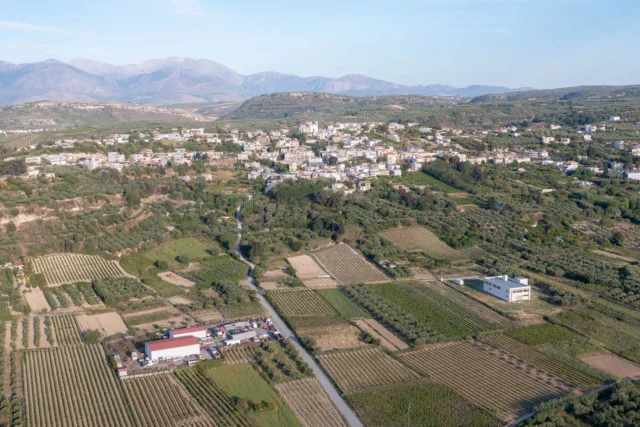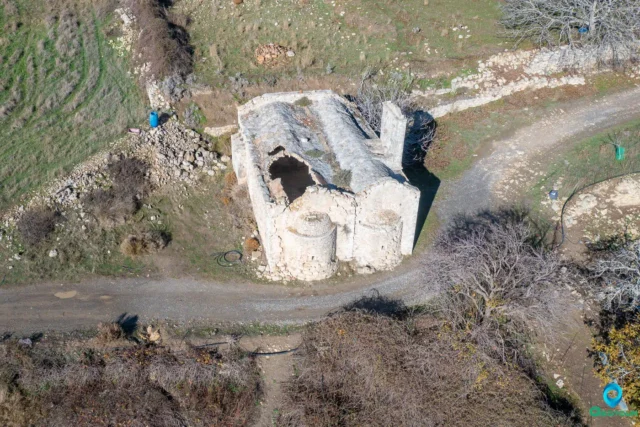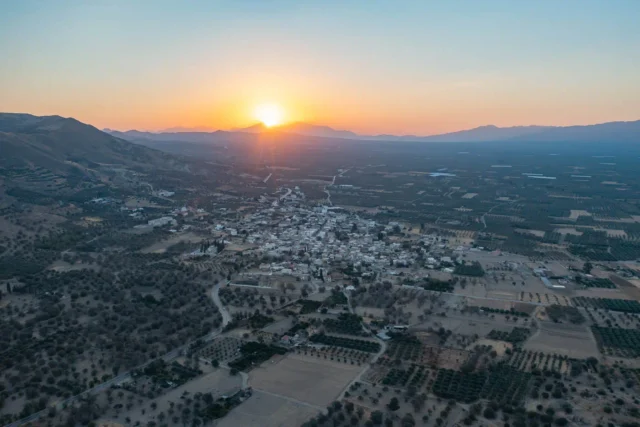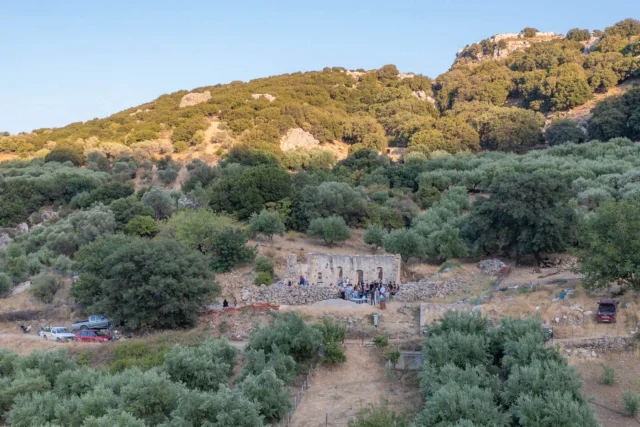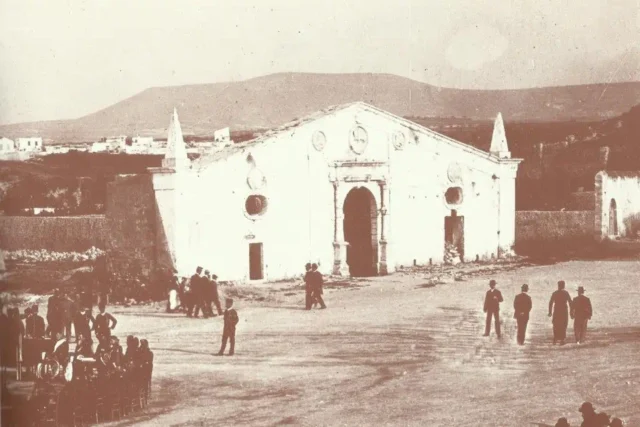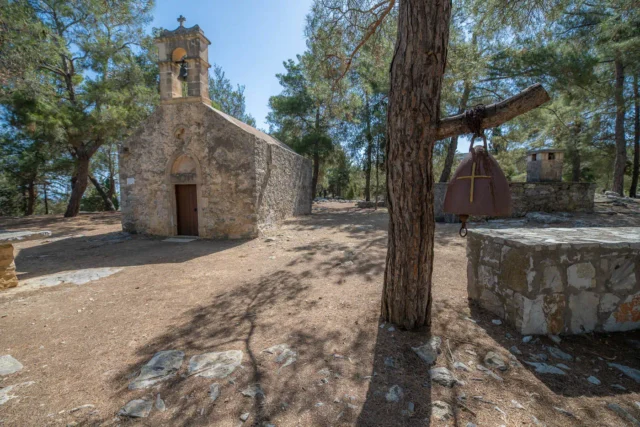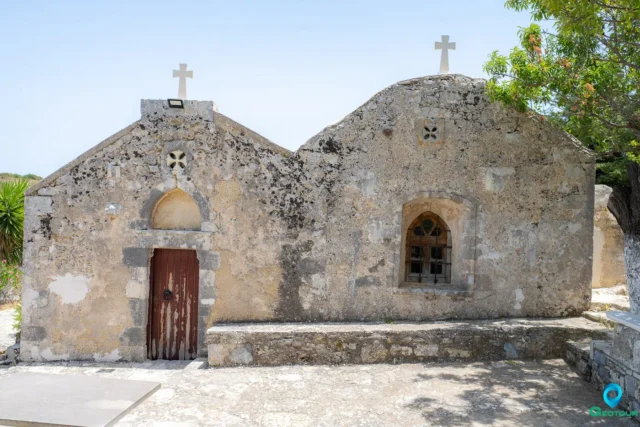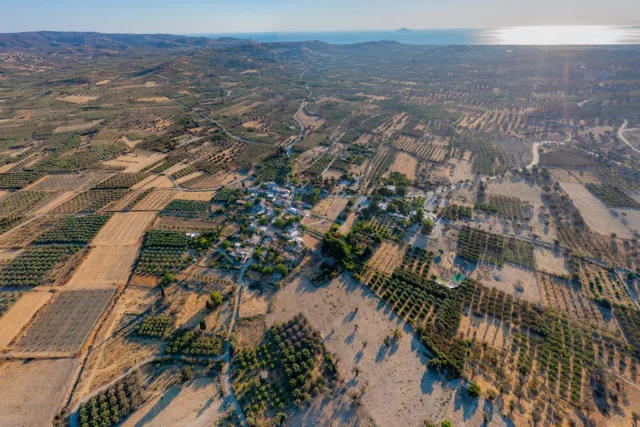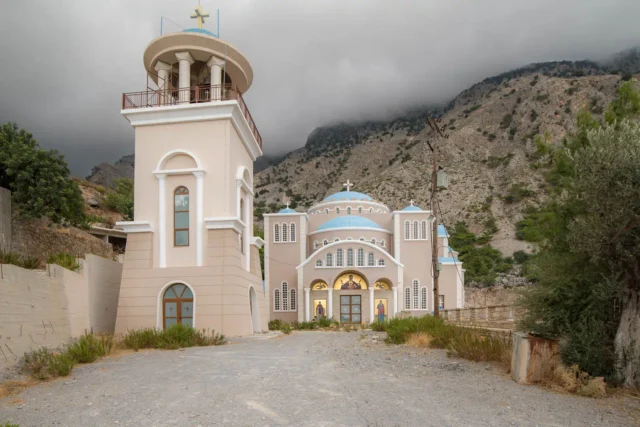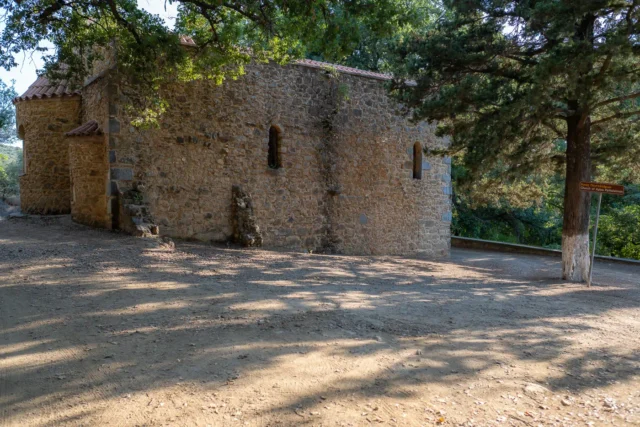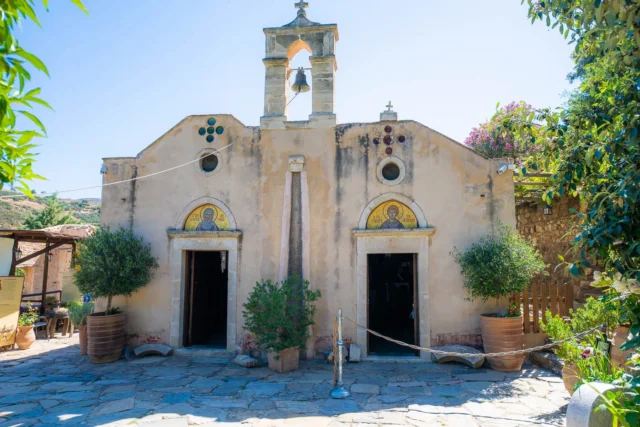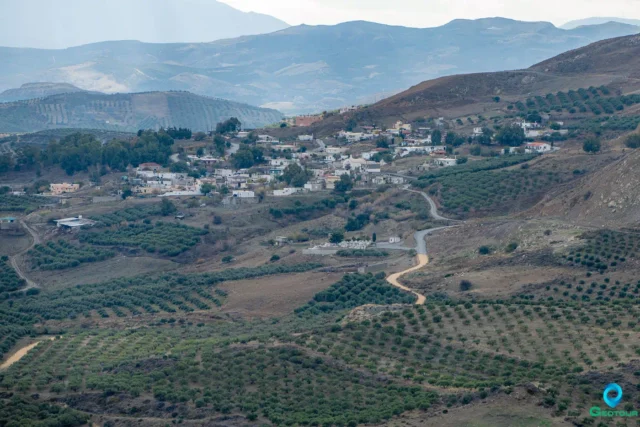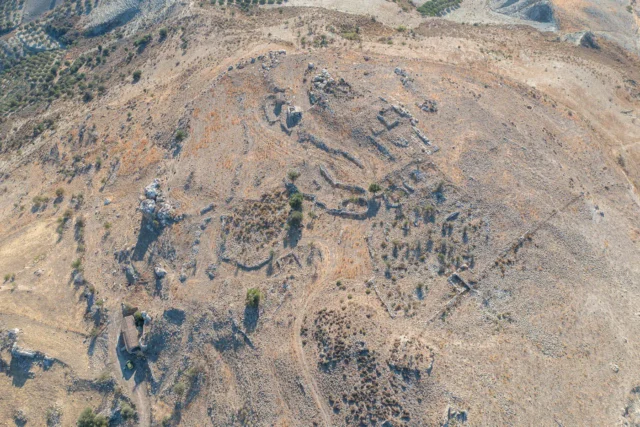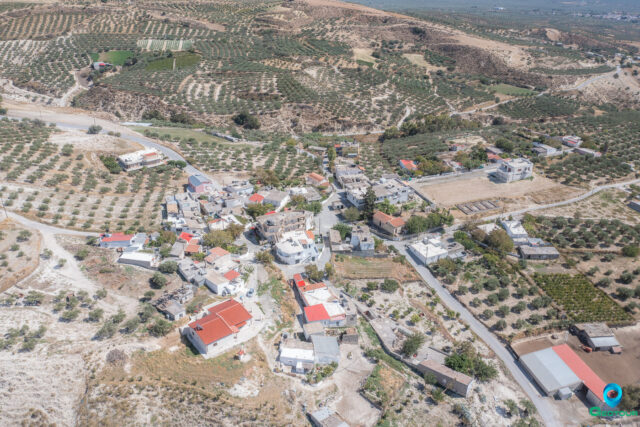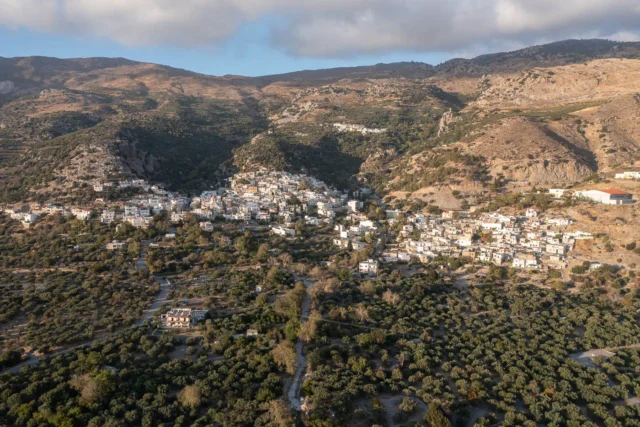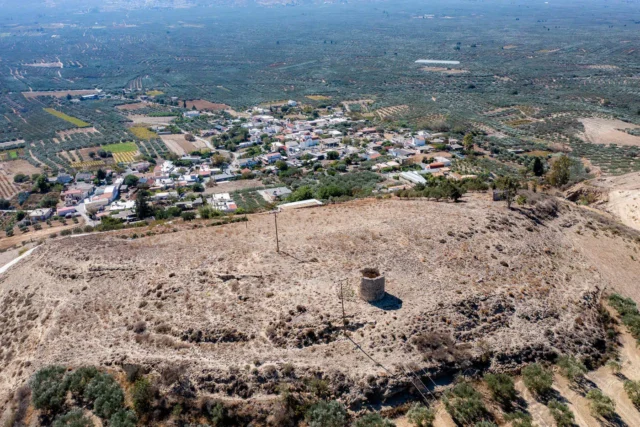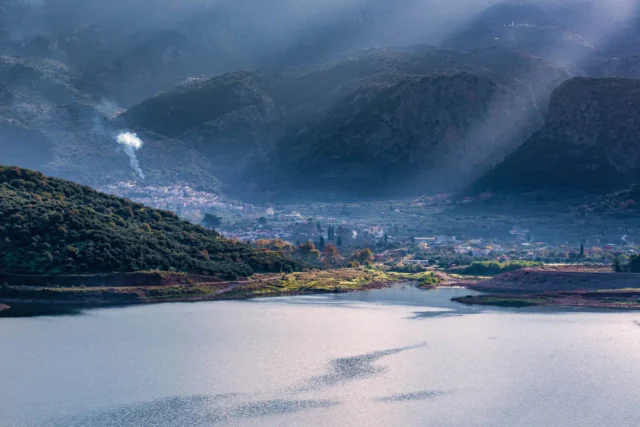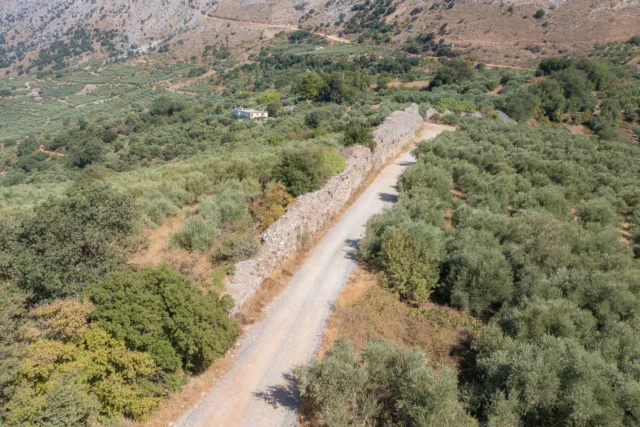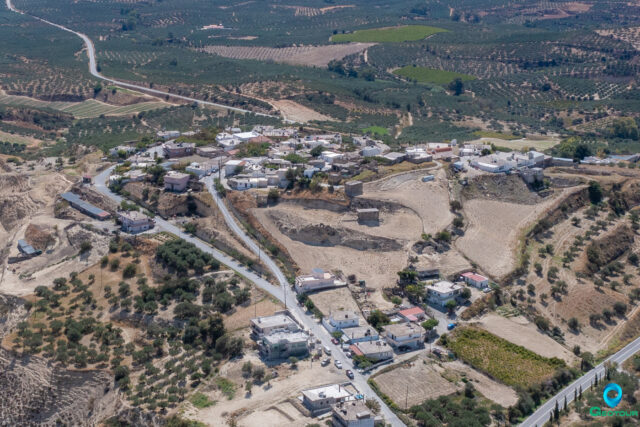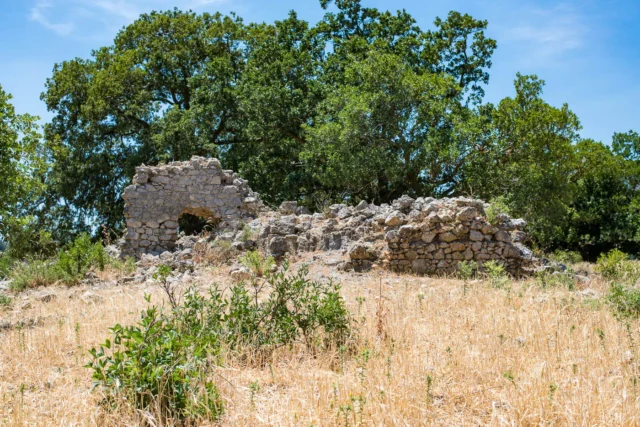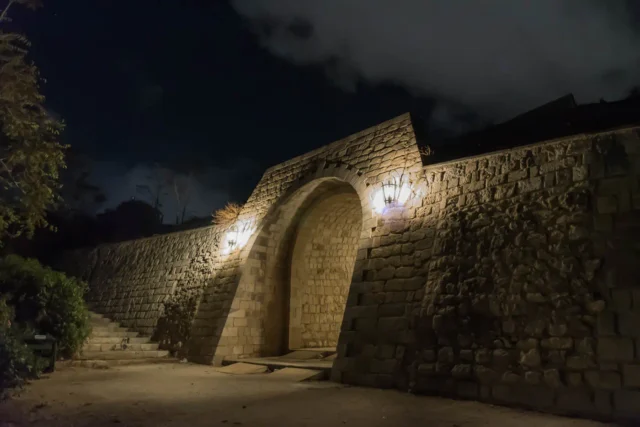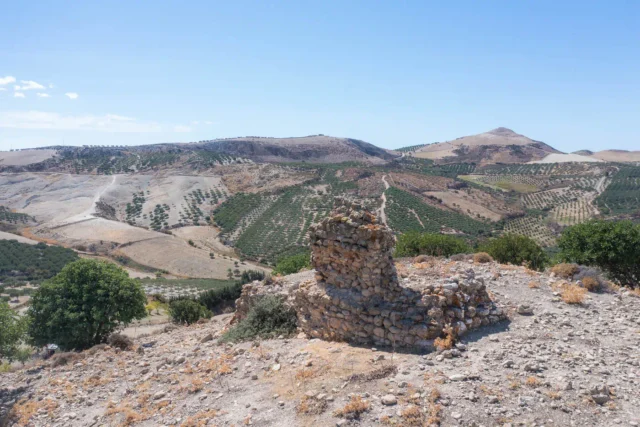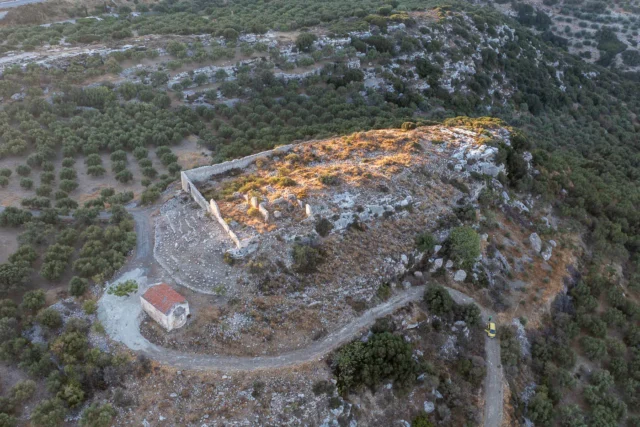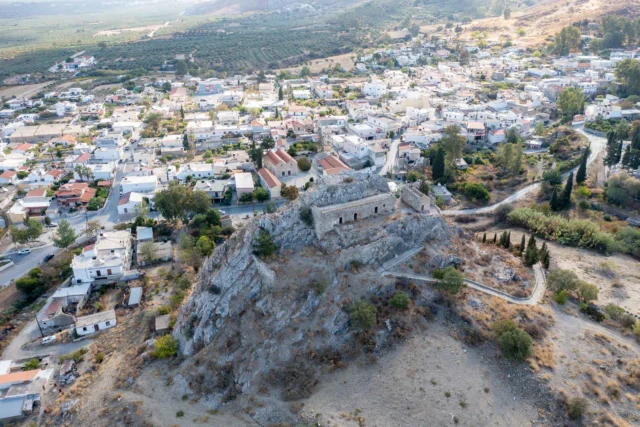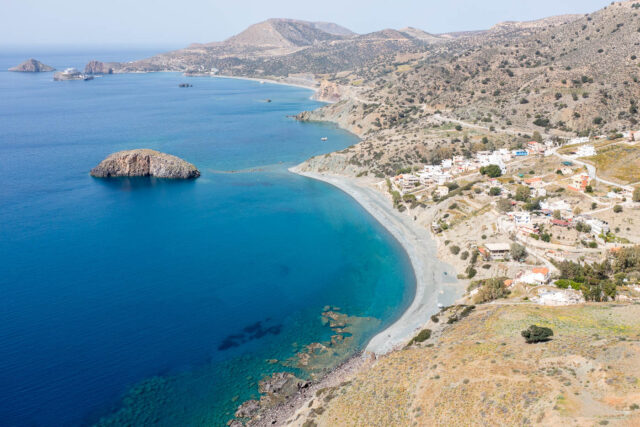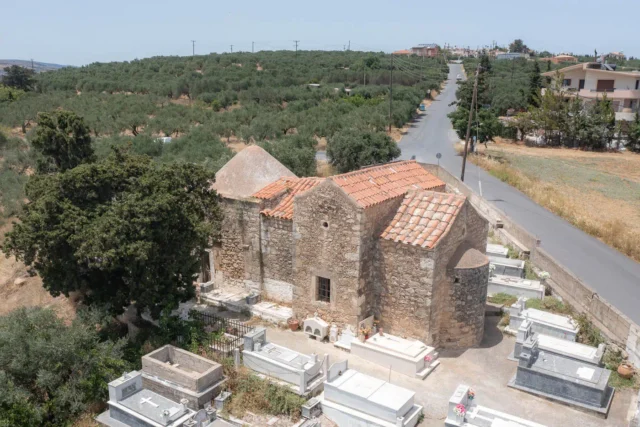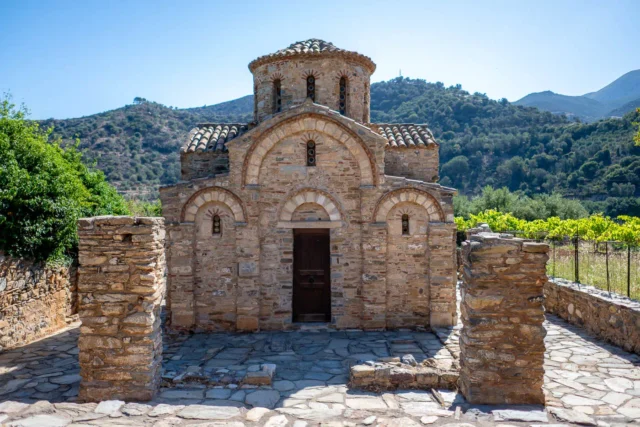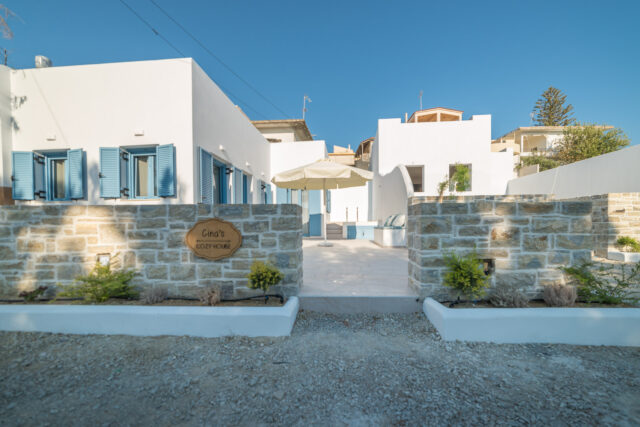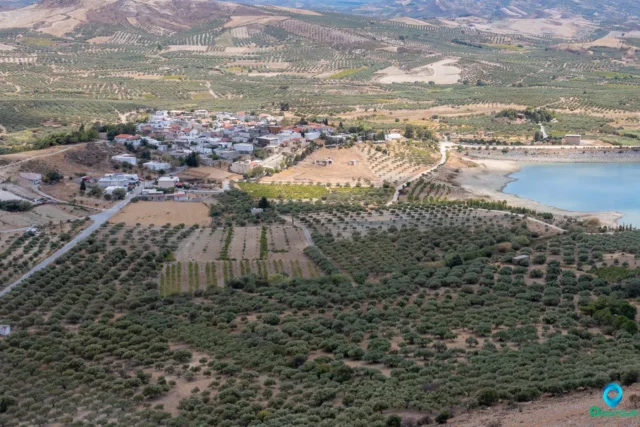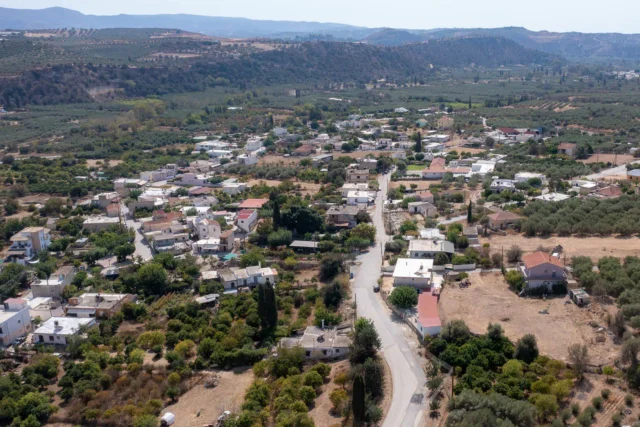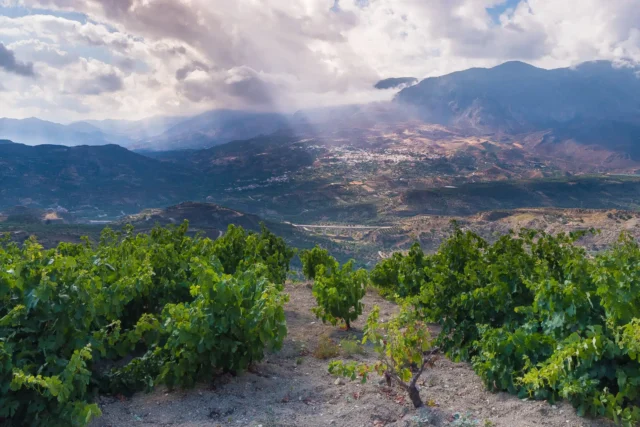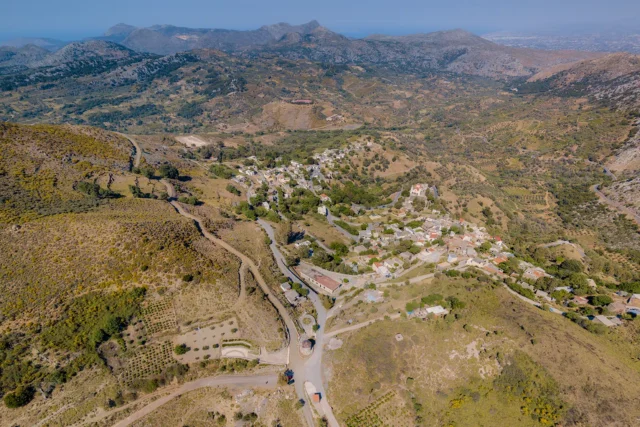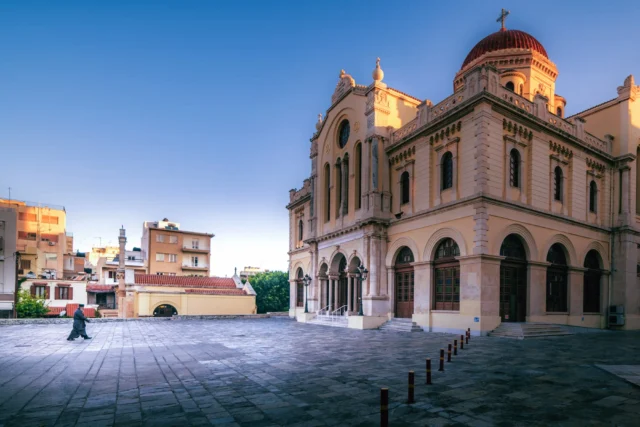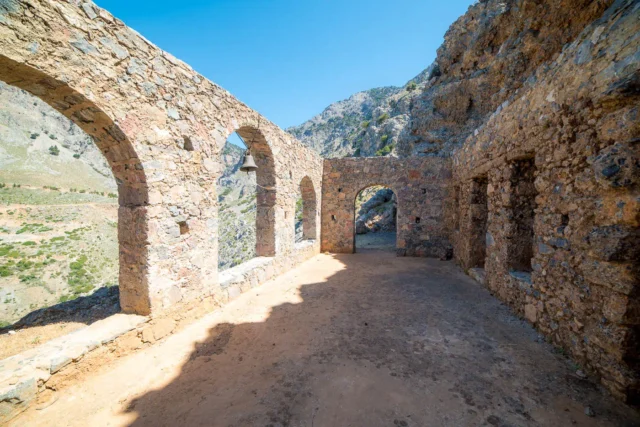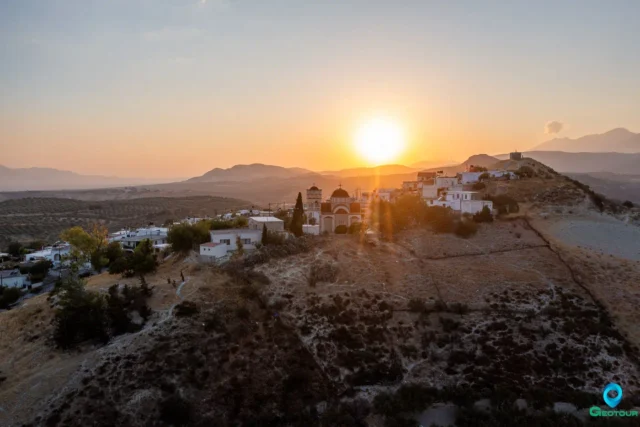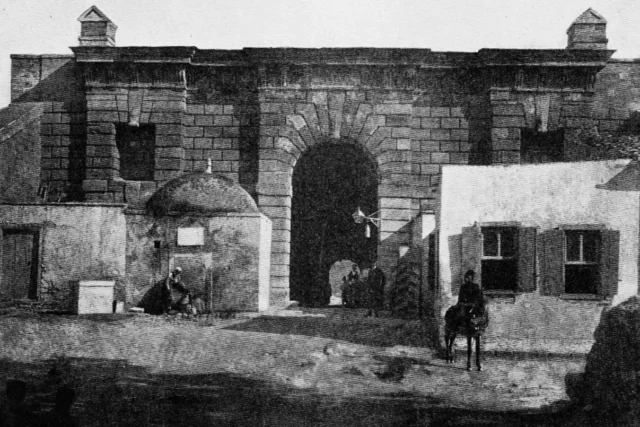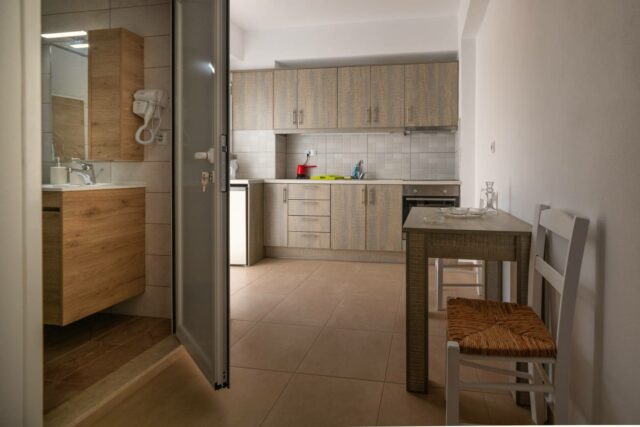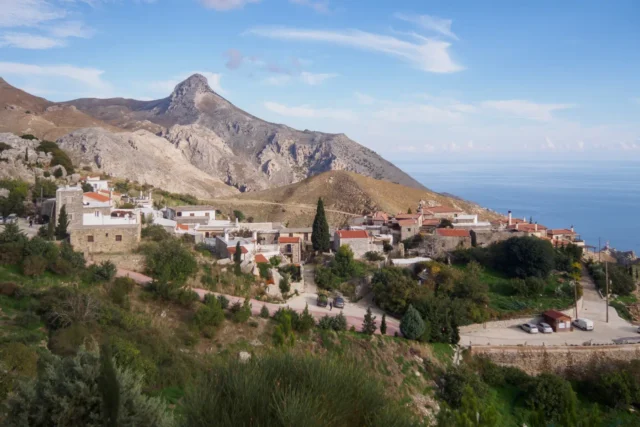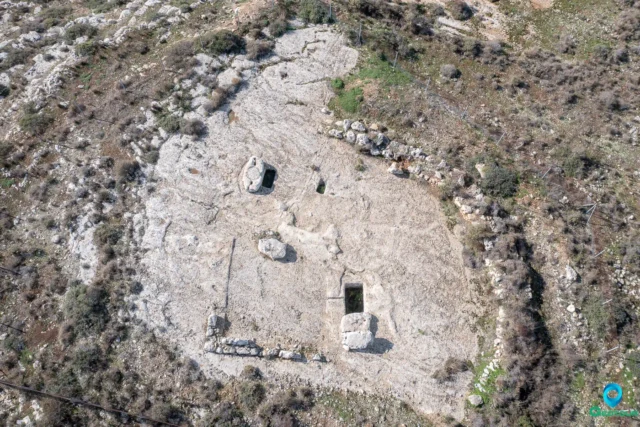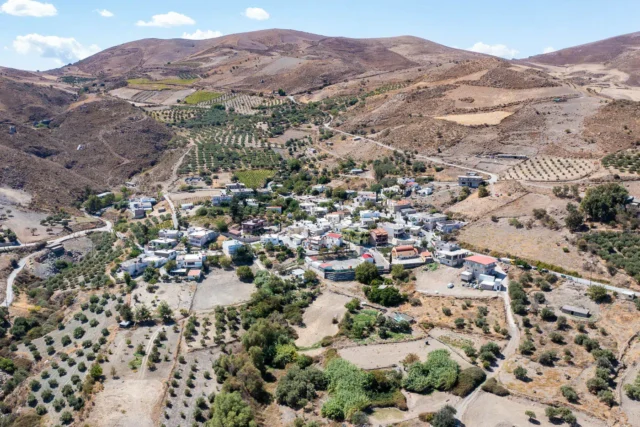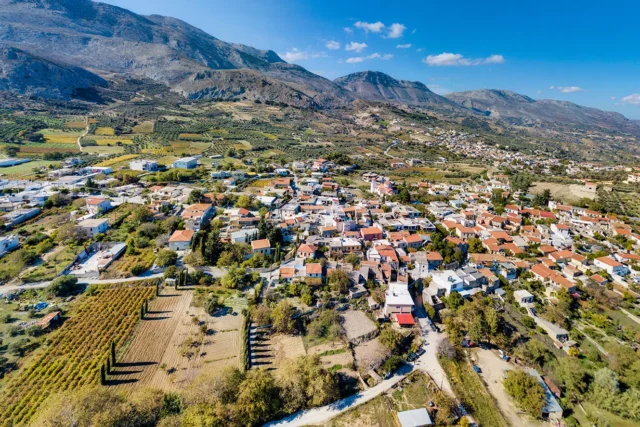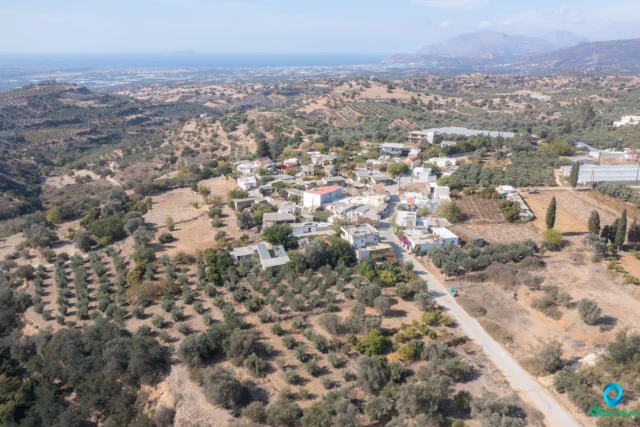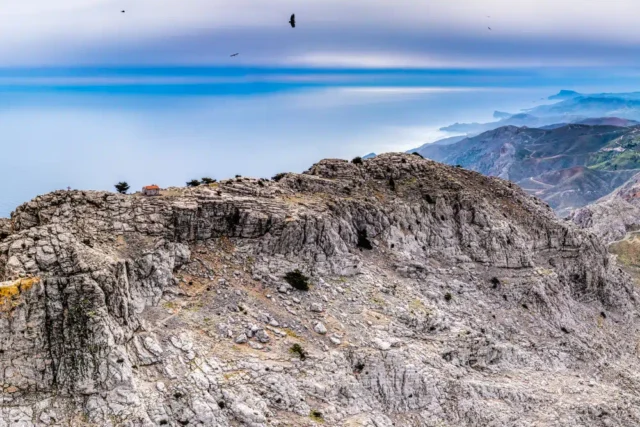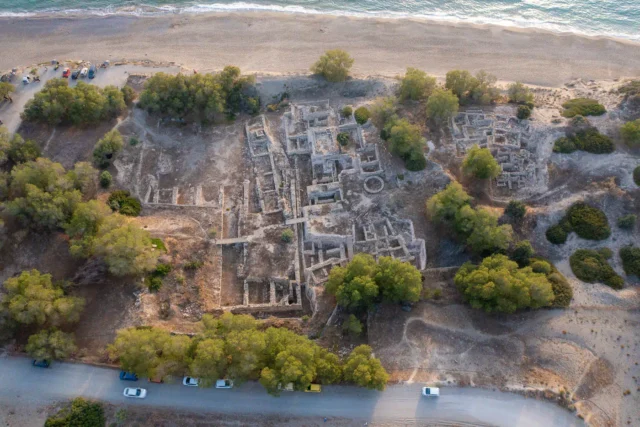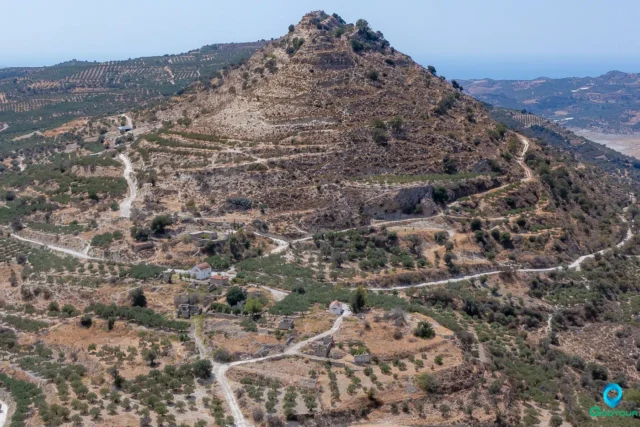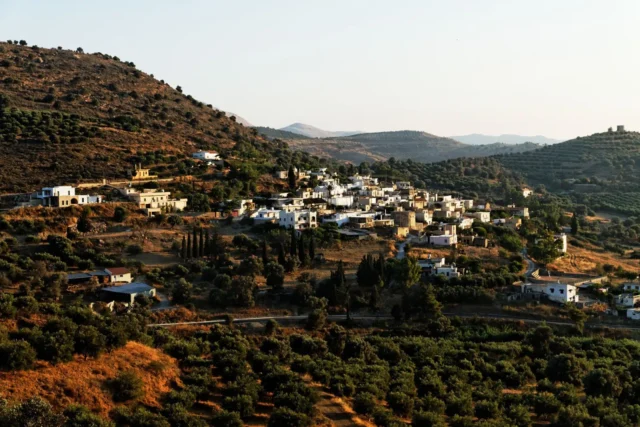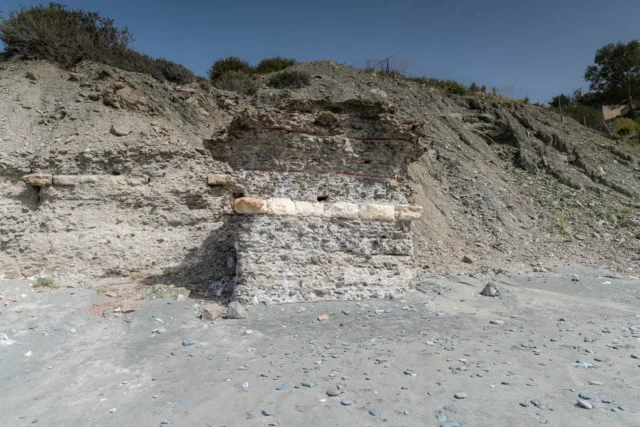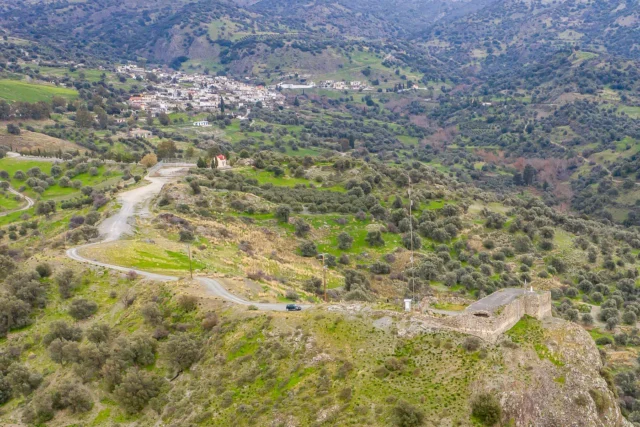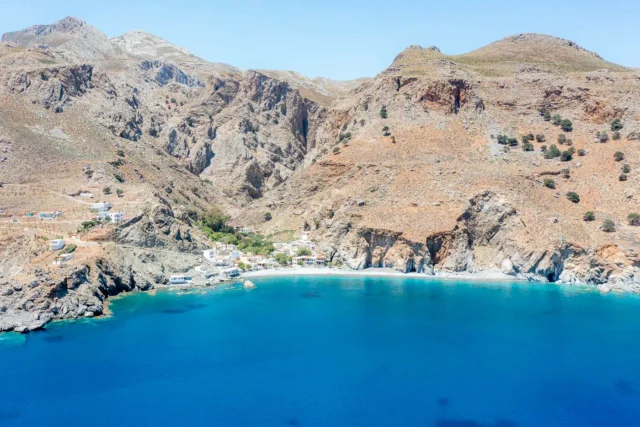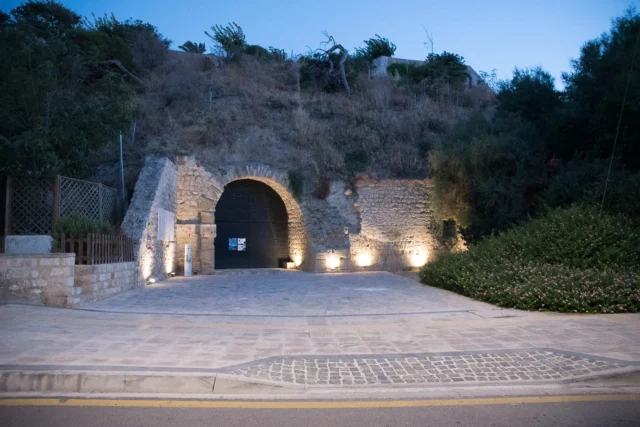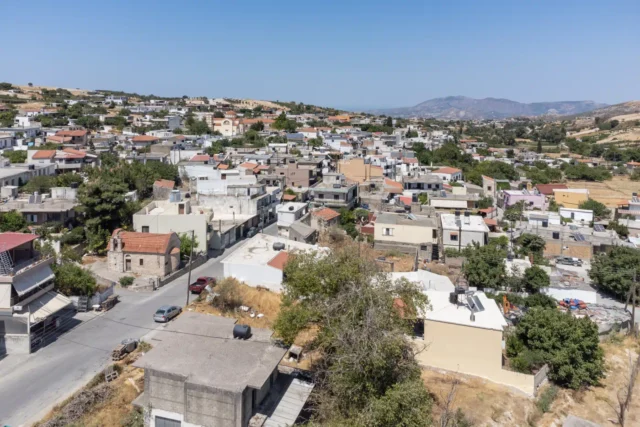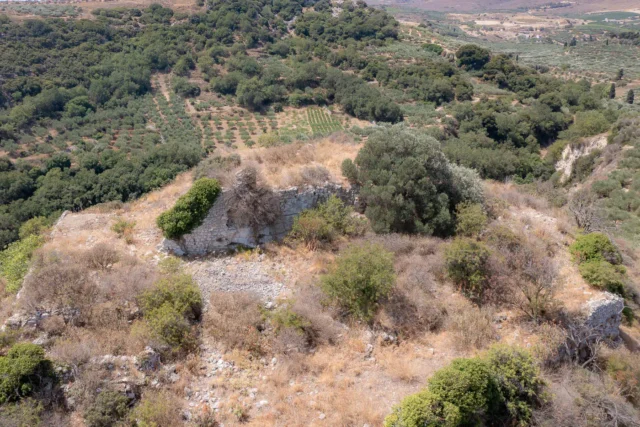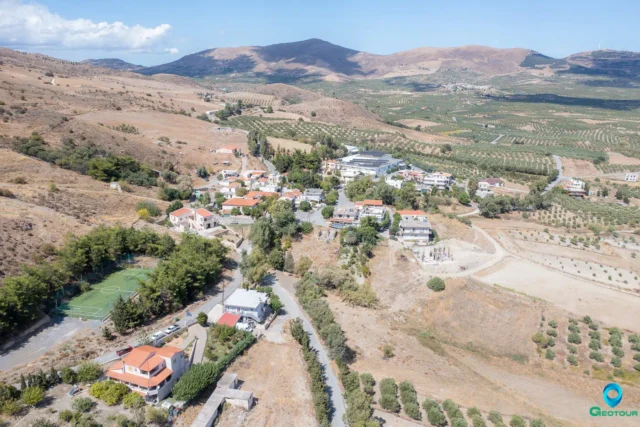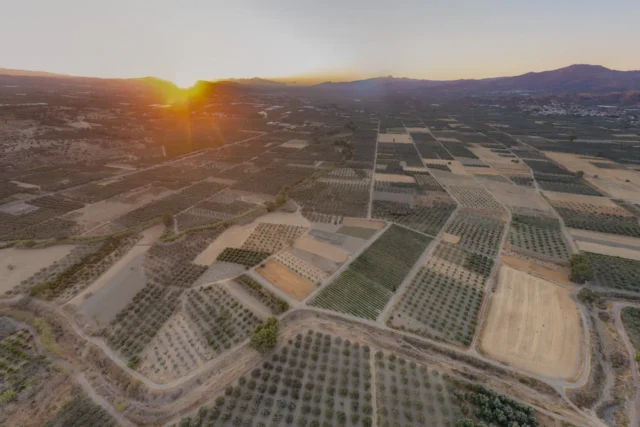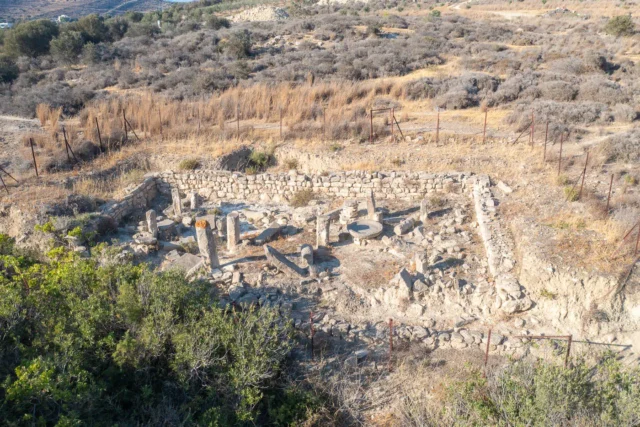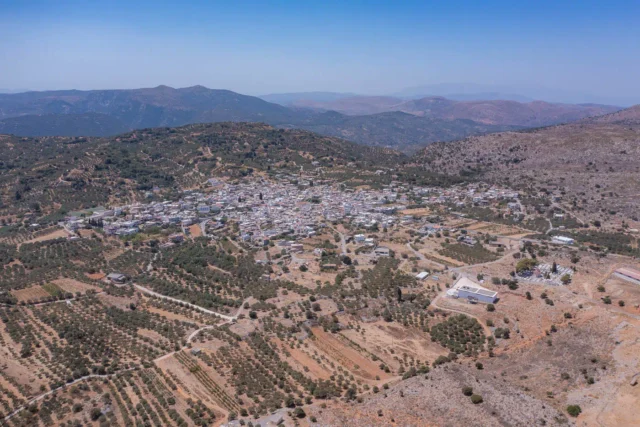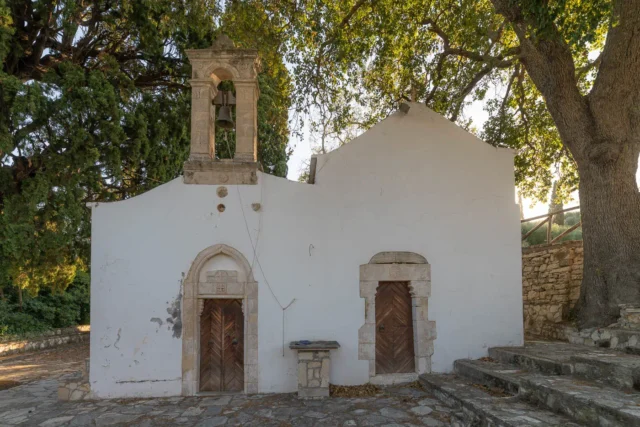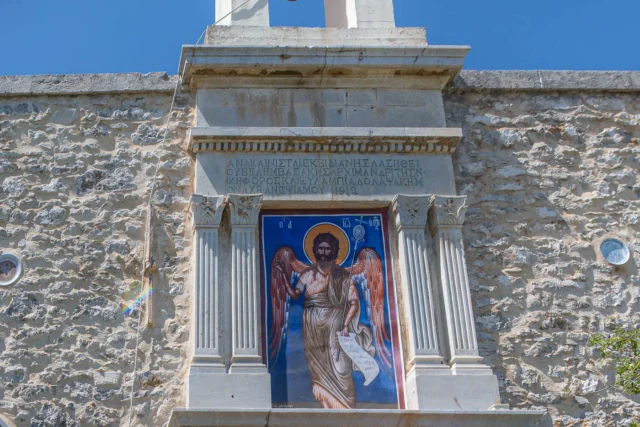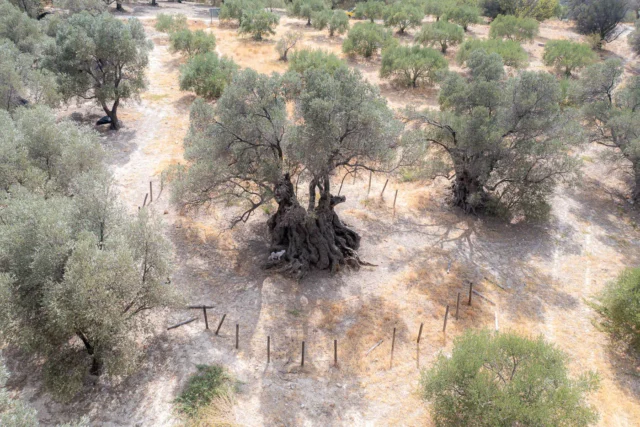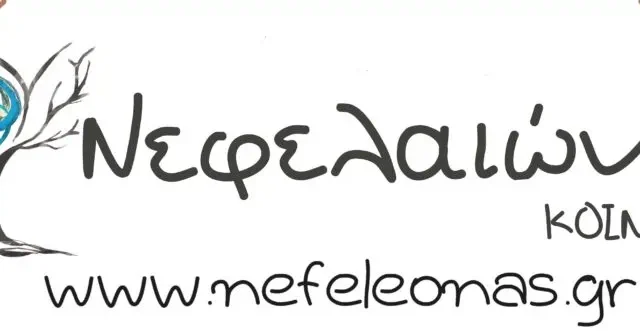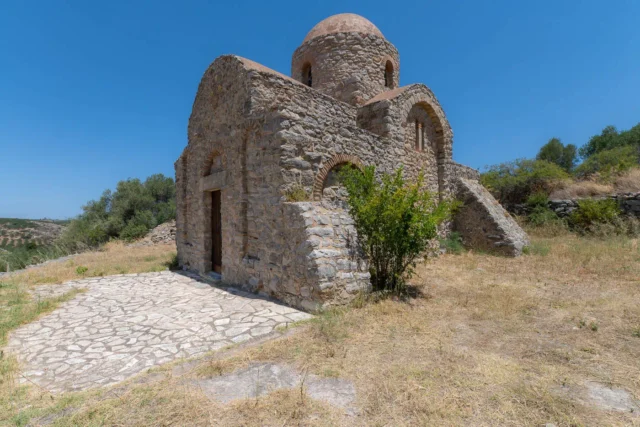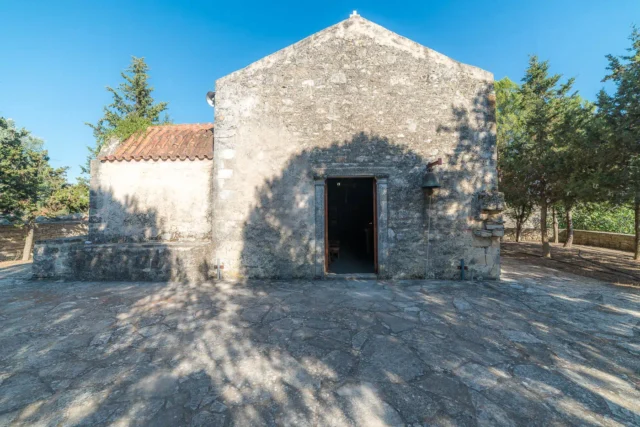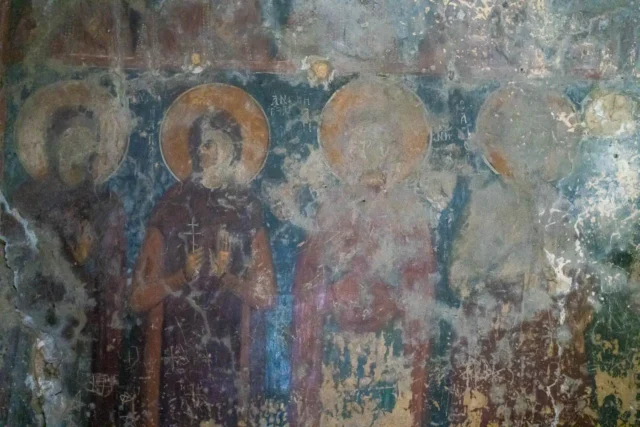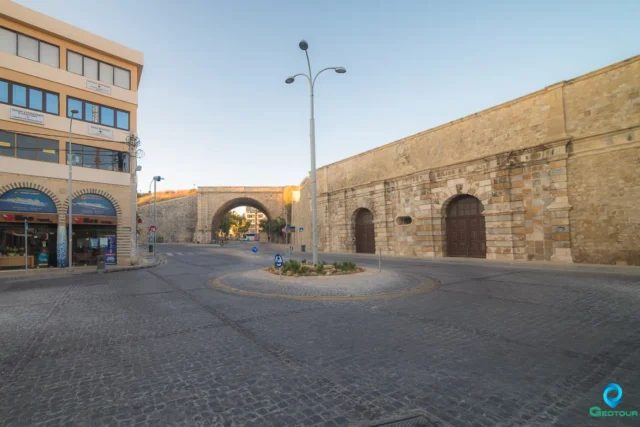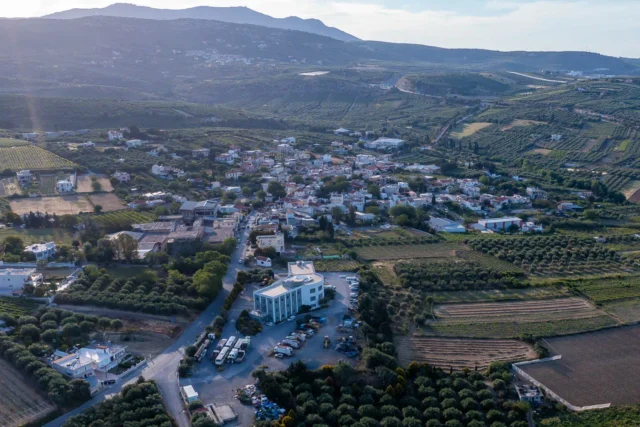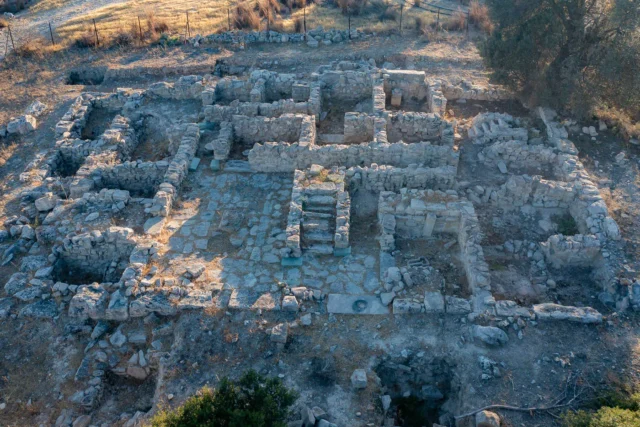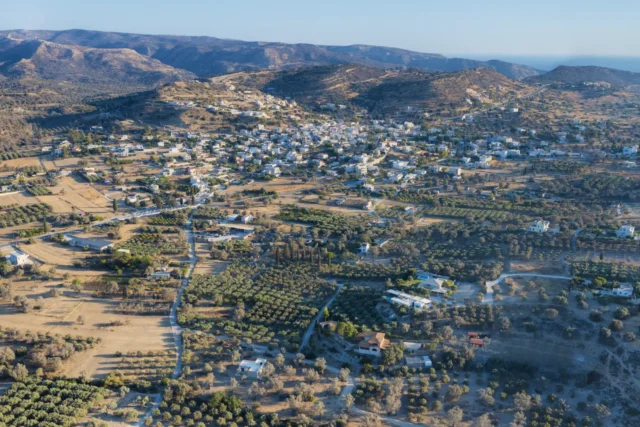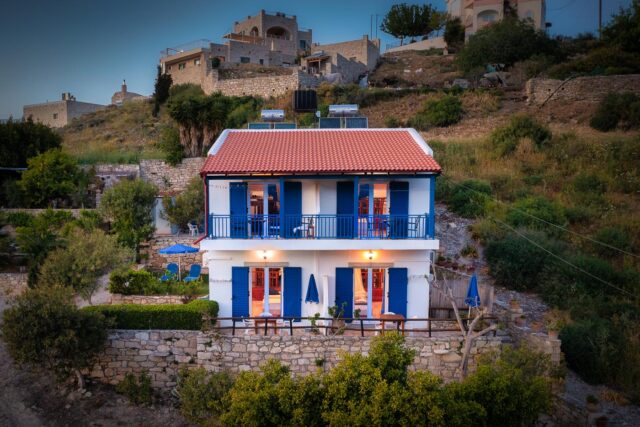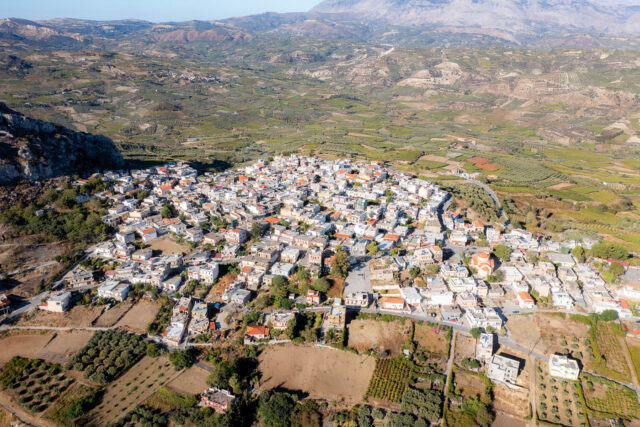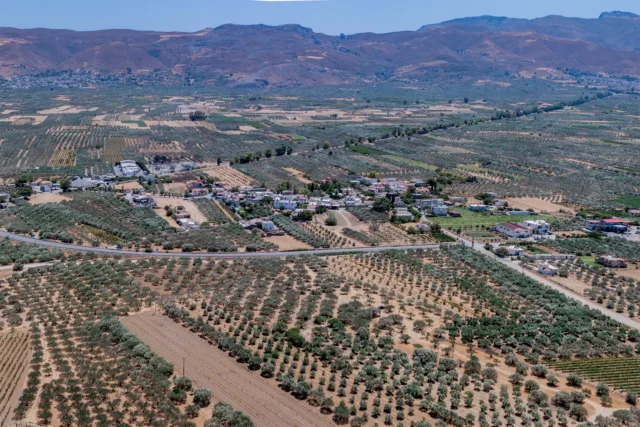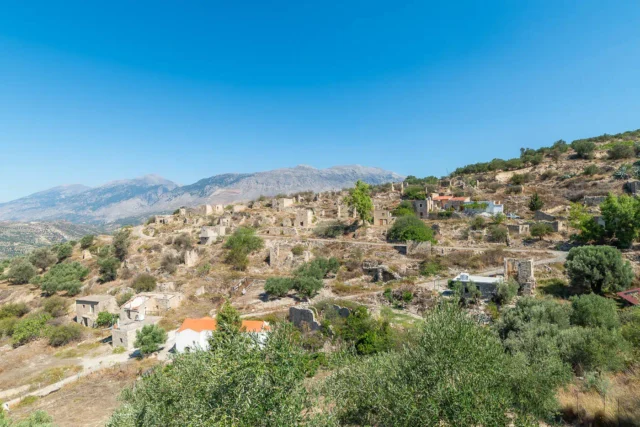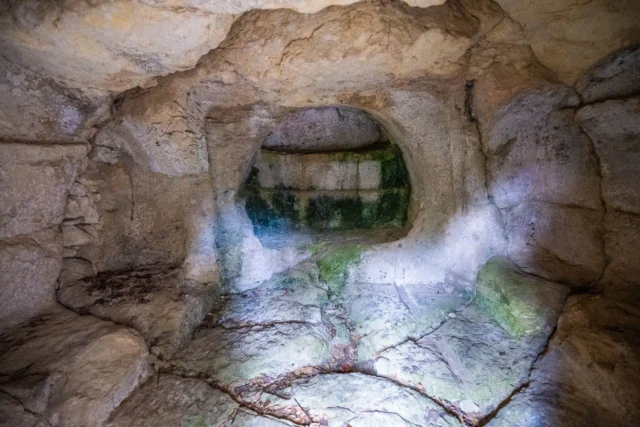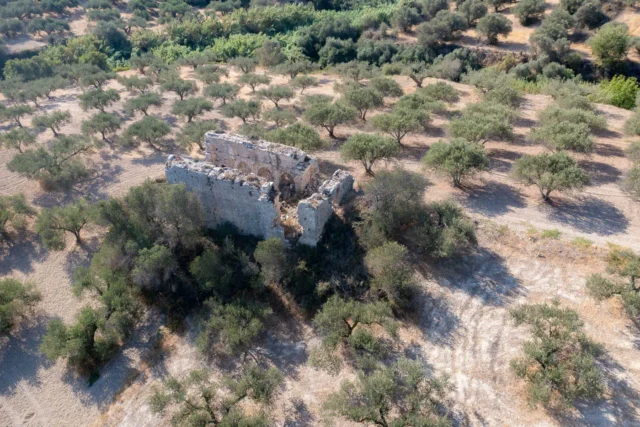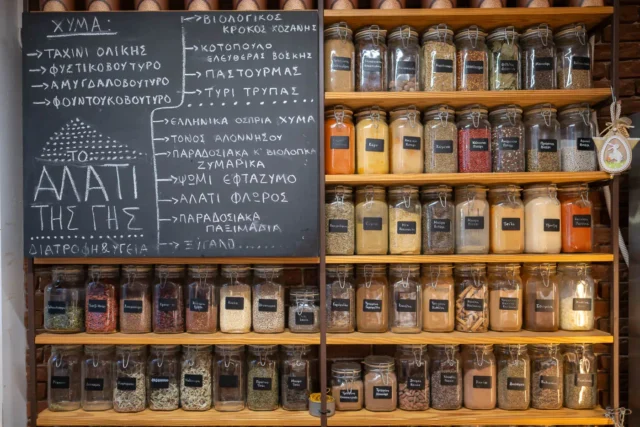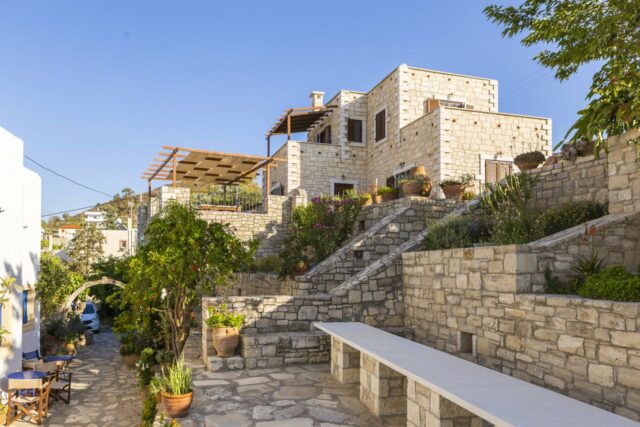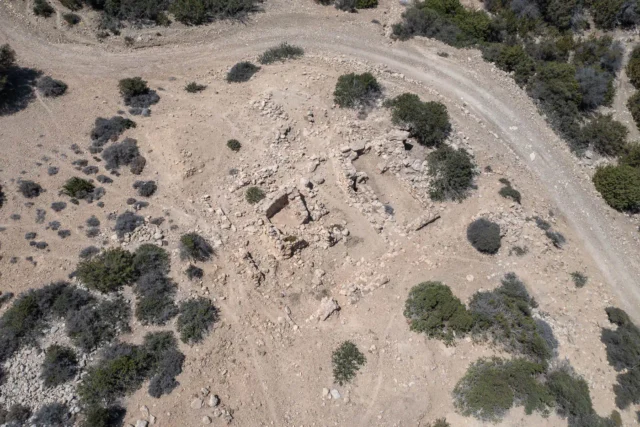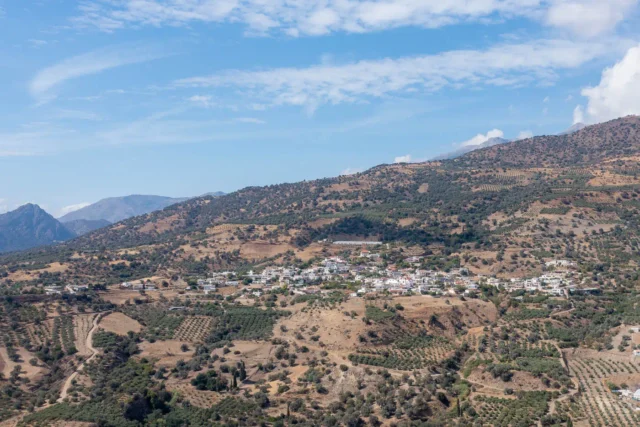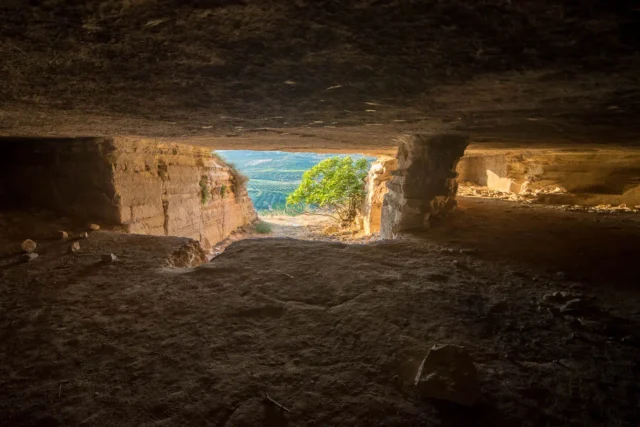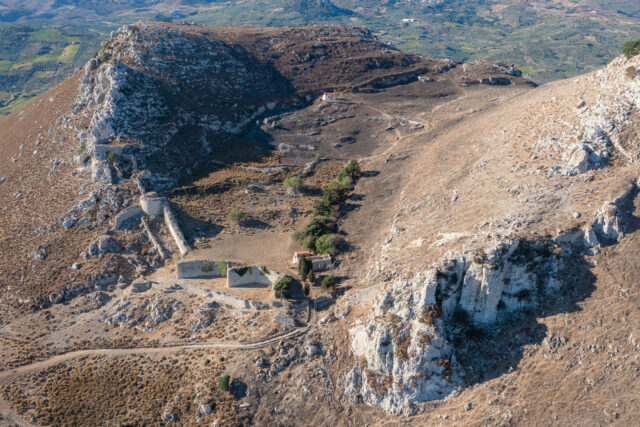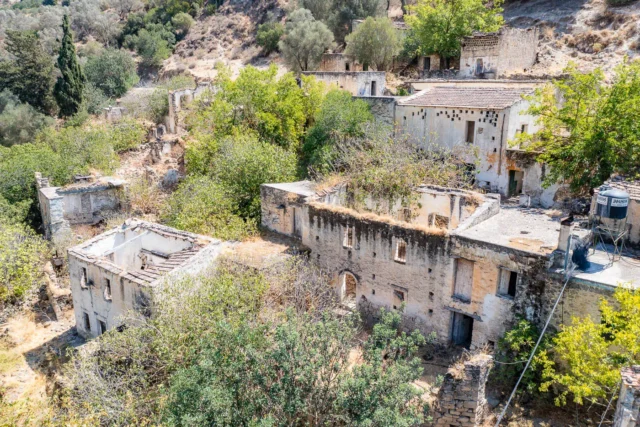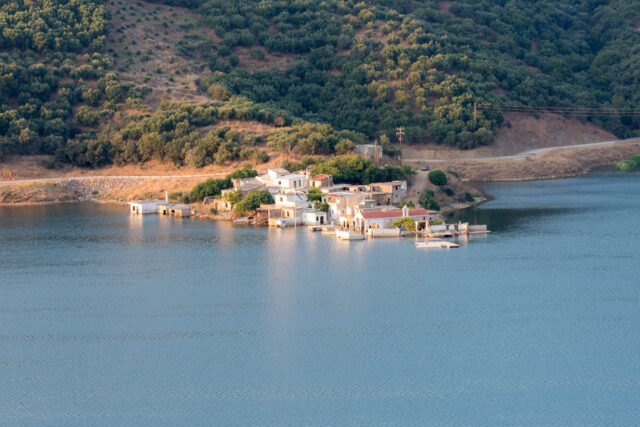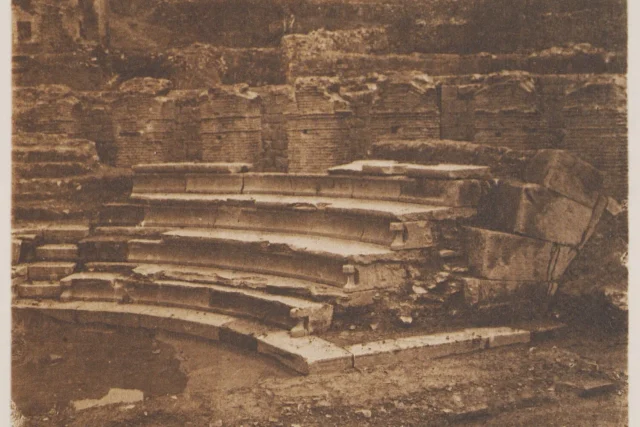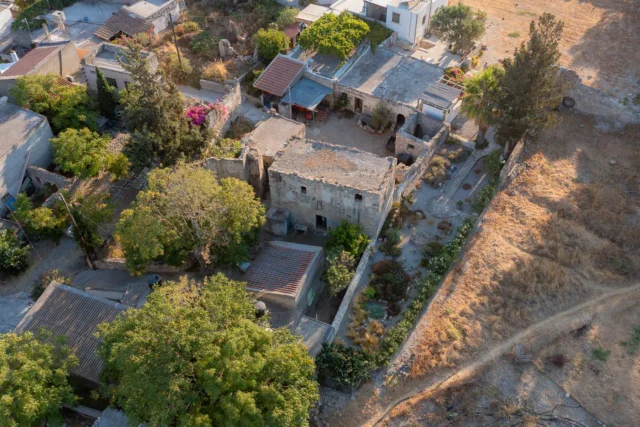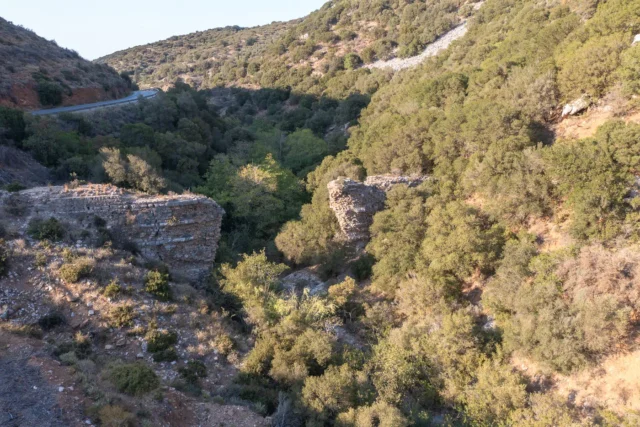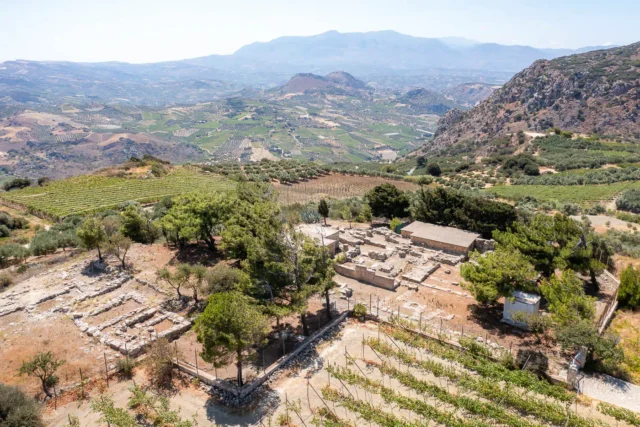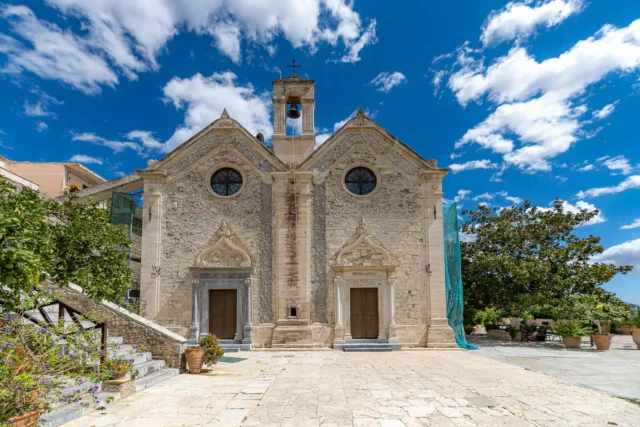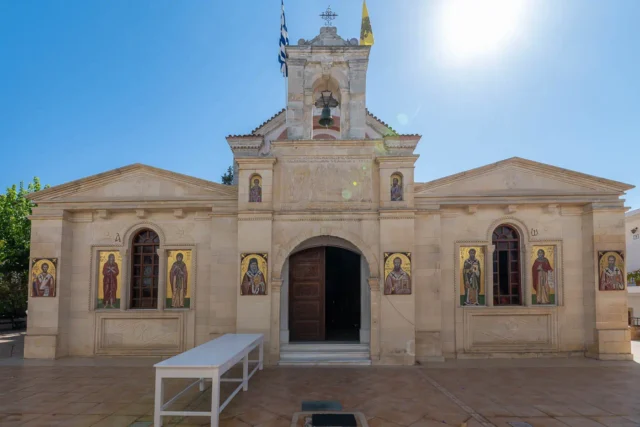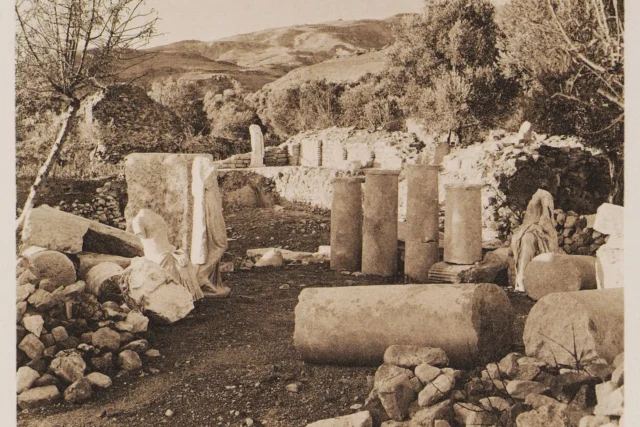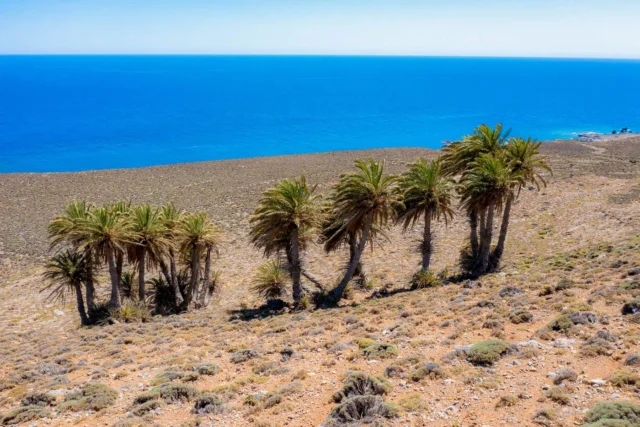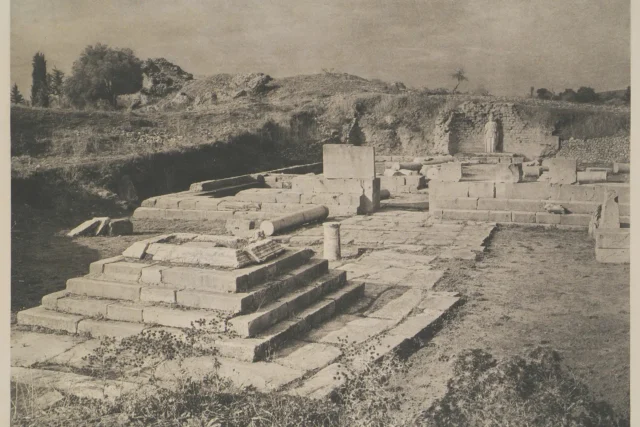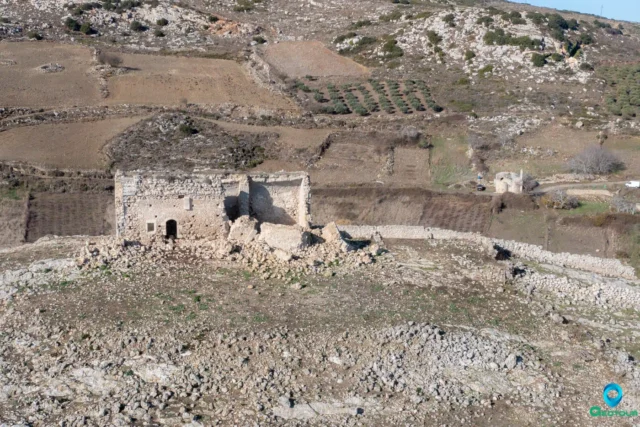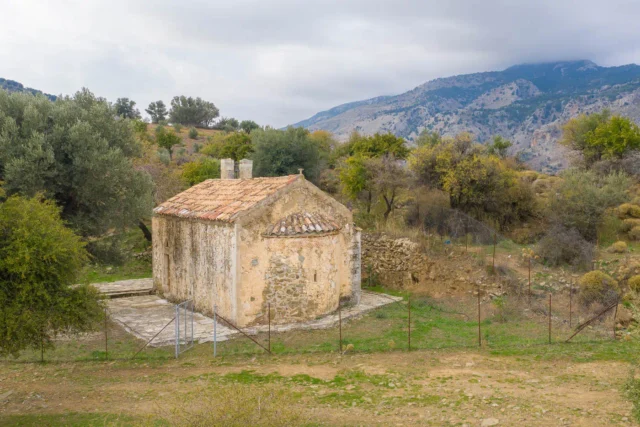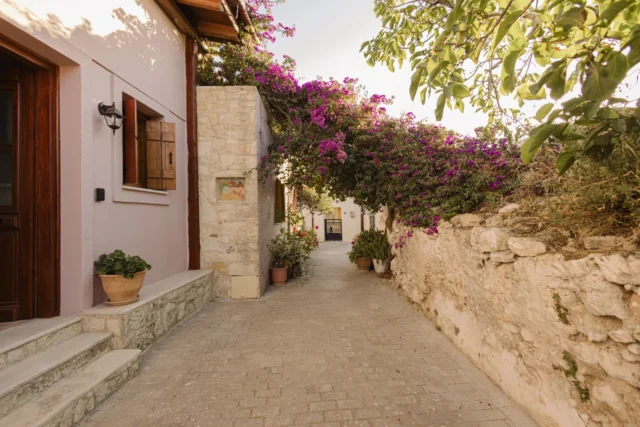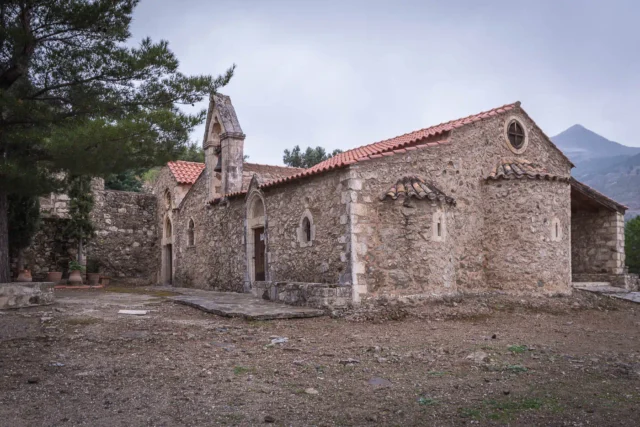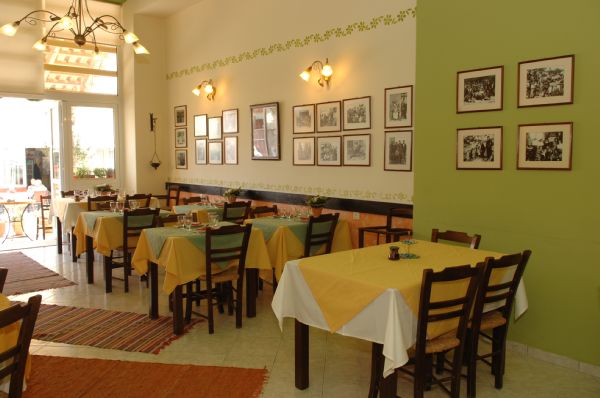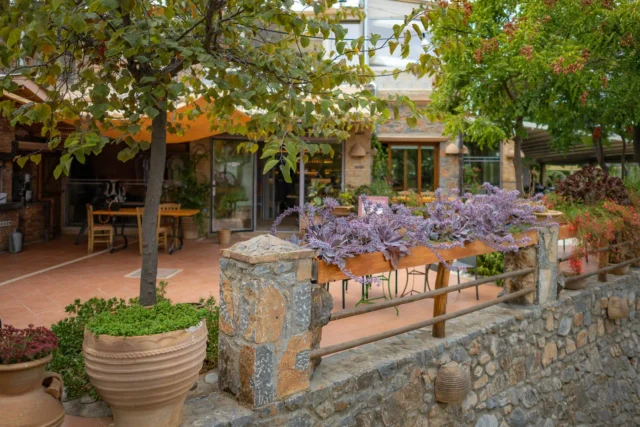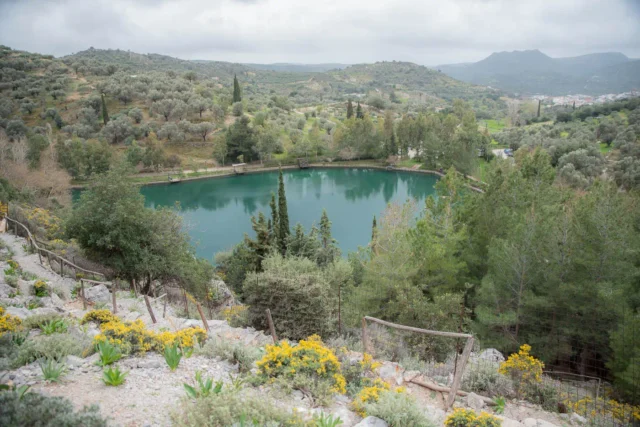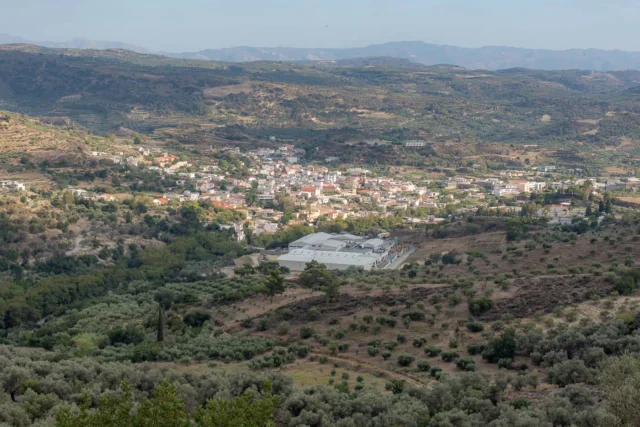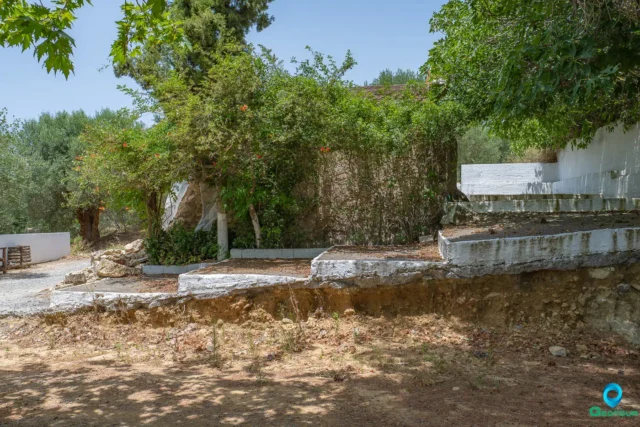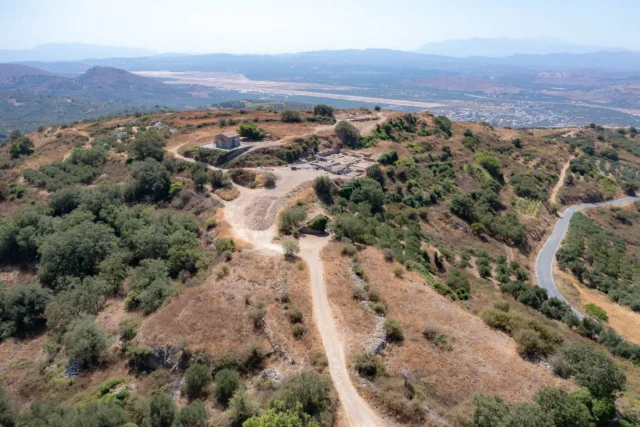
Ancient Lyktos (or Lyttos)
Lyttos, once known as Lyktos, is an ancient city steeped in history, with possible roots in the Minoan civilization. Archaeological evidence suggests a vibrant past, with the city flourishing through the Mycenaean, Archaic, Classical, Hellenistic, and Roman periods. The city's strategic location and powerful alliances contributed to its prominence in Crete. Excavations have revealed significant structures, including fortifications, public buildings, and residential areas, offering a glimpse into Lyttos' rich cultural heritage.
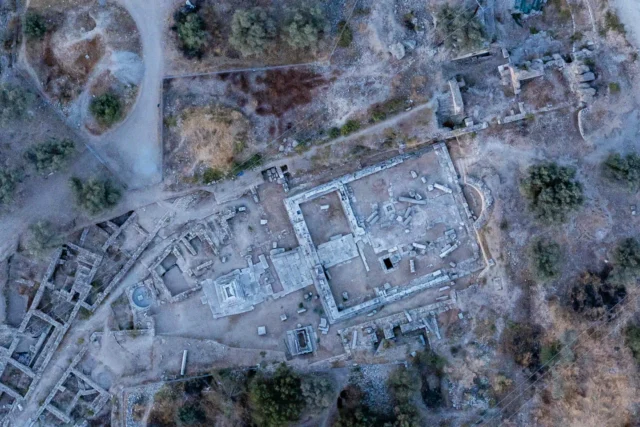
Gortyna archaeological site
8:00 am - 7:00 pm
Gortyna, located on Crete's Mesara Plain, was a major ancient city second only to Knossos. Inhabited since the Neolithic period (7000 BC), it flourished during the Bronze Age under Minoan and Mycenaean civilizations. By the Archaic and Classical periods, Gortyna was a powerful city-state, sometimes allied with, sometimes rivaling, Knossos. In 67 BC, Romans conquered Crete, making Gortyna capital of the province of Crete and Cyrenaica. The city thrived under Roman rule, with new infrastructure like the Praetorium, amphitheater, and Sanctuary of the Egyptian Gods.
A key discovery is the Gortyn code, the oldest known complete ancient Greek law, offering insights into 5th century BC social, economic, and legal structures. Gortyna embraced Christianity during the Byzantine era, evidenced by the Basilica of Saint Titus. The Arab conquest in the 9th century AD led to its decline. Today, Gortyna is a major archaeological site with ongoing excavations. Key sites include the Praetorium, Odeon (housing the Gortyn code inscription), amphitheater, Pythion Theater, Sanctuary of the Egyptian Gods, Basilica of Saint Titus, and Acropolis.
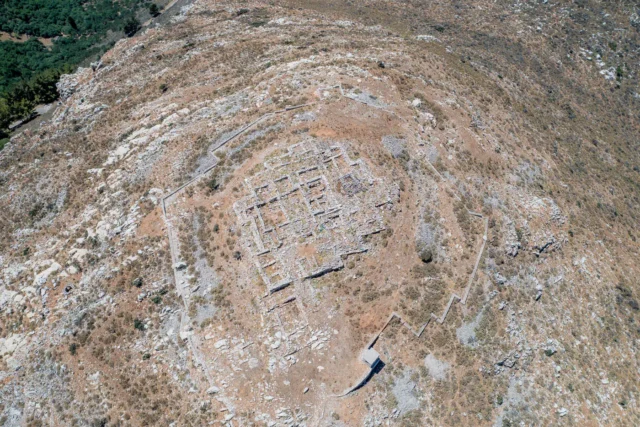
Acropolis Smari
The Acropolis of Smari, located on the peak of Prophet Elias near Smari, Crete, is an archaeological site with ruins dating back to the Minoan period (1800 BC to 630 BC). The site features a sanctuary dedicated to Athena Ergani, with ceramic plaques depicting the goddess considered the oldest representations of Athena in Crete. The Acropolis is enclosed by a strong defensive wall and contains settlements, buildings, and terraces for cultivation. Excavations have revealed structures like Megaron A, Megaron B, and Megaron Δ, each with unique features. The walls surrounding the hilltop are the most significant structures, built with large limestone blocks and smaller rectangular stones.

Afrati, Viannos
Afrati is a traditional village in Viannos, Crete, situated 45 km southeast of Heraklion at an altitude of 480 meters. The village features traditional architecture, and residents are primarily involved in olive and grape cultivation. The origin of the village's name is uncertain, with possible links to the Greek word for "foam," the ancient city of Arcadia, or the Latin word for "monk."
The area around Afrati has been inhabited since ancient times. The nearby hill of Prophitis Ilias was home to the ancient city of Arcadia, which minted its own coins and later became a bishop's seat. Archaeological excavations have revealed ancient houses, a necropolis, and a 7th-century BC oinochoe (wine jug). Afrati first appears in historical records in the 1881 Turkish census as "Frati." The village features the Church of the Transfiguration of the Savior and offers access to the ruins of Arcadia.
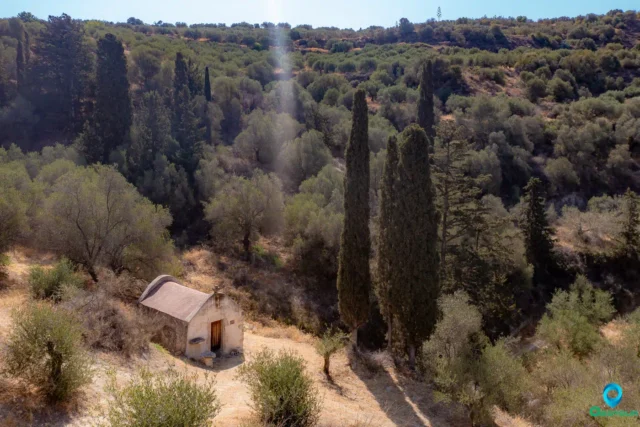
Agia Paraskevi in Aitania
Agia Paraskevi, a 14th-century Byzantine church near Aitania village in Crete, is adorned with well-preserved frescoes depicting saints like Vlasios, Titus, and John the Theologian, alongside biblical scenes. The church, accessed via a steep dirt road, features a single room and a sanctuary with unique motifs like the Melismos and Christ as the Great High Priest. Frescoes on the north and south walls portray various saints, including military saints, while the arch showcases scenes from the Dodekaorton. Local tradition recounts miraculous healing associated with the church, with a ritual involving holy water from a now-dried spring. Restored in 2003, the church's exterior is simple, with a buttress and a stone table used for bread blessing during festivals.

Agios Myronas, Heraklion
Agios Myronas, a picturesque village in the Heraklion region of Crete, boasts a rich history dating back to the Minoan era. The area was once home to the ancient city of Raikos, and archaeological remnants from this period, along with artifacts from the Roman era, are now housed in the Heraklion Archaeological Museum. The village, nestled on two hilltops at an altitude of 450 meters, offers stunning views of the surrounding landscape.
Named after Saint Myron, a 4th-century Bishop of Crete who was born in ancient Raikos, Agios Myronas has been a site of resistance throughout history, with villagers actively participating in uprisings against Ottoman rule and the Axis occupation during World War II.
Today, the village thrives as a blend of old and new, with traditional architecture alongside modern amenities. Its approximately 720 residents are primarily engaged in agriculture and livestock farming, particularly renowned for their grapes and wine production. Agios Myronas features a primary school, a secondary school, a high school, a police station, a post office, and a regional medical center, ensuring a good quality of life for its inhabitants. The imposing cathedral of Agios Myronas, housing the saint's tomb and relics, is a significant landmark, and the annual festival on August 8th celebrates Saint Myron's feast day.
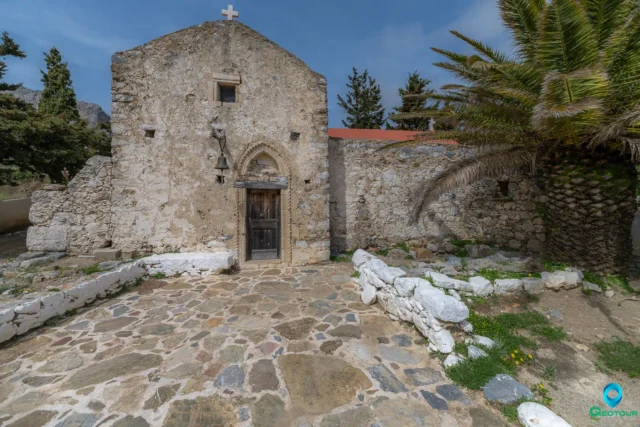
Agios Pavlos Monastery near Paranymfoi
The Agios Pavlos Monastery is a Venetian-era ruin near Paranymfoi, Crete. Located in the Asterousia Mountains, it once served as a hermitage and monastery. The site features a single-aisled basilica church with traces of frescoes, a carved doorway, and ruins of monks' cells. The monastery, linked to the scholar Iosif Filagris, flourished during the Venetian period but was abandoned in the 20th century. The surrounding area shows signs of inhabitation since antiquity, including possible evidence of an ancient sanctuary. The monastery is accessible by a dirt road from Paranymfoi and is situated above the Porofarago gorge, near the hiking trail to Tries Ekklisies.

Aitania, Chersonissos
Aitania, a village in Heraklion, Crete, is 20 km from Heraklion. Its name is believed to be a corruption of the ancient city of Diatonion. Aitania is recorded in a Venetian document from 1212 as "Icania." The Venetian census of 1583 lists it as "Itagnia Cato" with 112 inhabitants and "Itagnia Apano" with 85 inhabitants. On October 12, 1856, a major earthquake with a magnitude of 8.2 struck Crete, causing significant damage and resulting in the death of 40 people in Aitania. In 1954, archaeologist N. Platon excavated a small, cave-like carved tomb west of Aitania at a site called "Fonias." The tomb contained approximately thirty Geometric period vessels. The village square is a central gathering point for residents and visitors, with traditional cafes. The Cultural Association of Aitania organizes a Cretan feast in the square every year on August 15th.
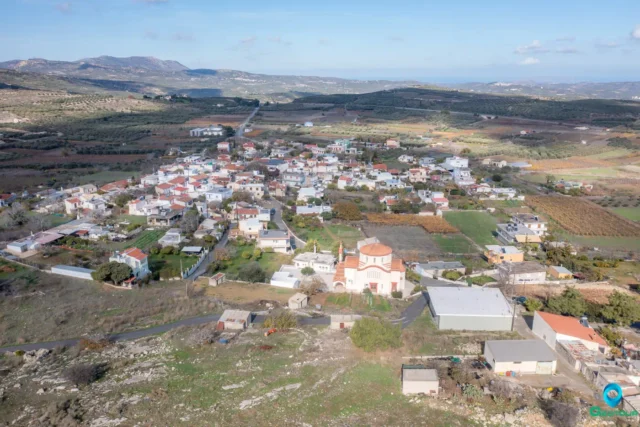
Alagni, Archanes - Asterousia
Alagni, a village 25 kilometers from Heraklion, Crete, has a history rooted in the Minoan civilization. The village's name is believed to be derived from the nymph Alagonia, and ruins of a temple dedicated to her are said to be found on Tholi hill. Alagni is near the Minoan palace of Galatas, built around 1700-1600 BC. The village itself is home to a Minoan farmhouse and appears in historical records as early as 1583.
Alagni has several notable churches: Agios Vlassis, Sotira, Agios Georgios, Panagia, Panagia of Rouma, and Agioi Apostoloi. The latter, built in the 15th-16th century, bears the emblem of the Venetian Cornaro family.
Other significant landmarks include the deserted settlement of Rouma and Koursamos, where a cluster of winepresses dating back to the 16th-17th centuries exists. The Tholi Fortress, a small fortress from the late Venetian period (16th-17th century), is located on a hilltop west of Alagni.
The village's economy has traditionally centered around agriculture, particularly the cultivation of grapes and olives for wine and oil production.

Amigdalos, Archanes - Asterousia
Amigdalos (Αμύγδαλος) is a small mountainous village in the Municipality of Archanes-Asterousia in the Heraklion Regional Unit, Crete, Greece. It is located at an altitude of 595 meters, approximately 50 km south of Heraklion and 37 km south of Epano Archanes. The village was first officially recognized as a settlement in 1925. The name "Amigdalos" means "almond tree" in Greek, likely named after the abundance of wild almond trees in the surrounding region. Amigdalos has experienced a steady population decline throughout the 20th and 21st centuries.

Amiras, Viannos
Amiras, a small village nestled on the southern slopes of Mount Dikti in Crete, boasts a rich history dating back to the Arab occupation of Crete (824-961 AD). Its name, derived from the Arabic word for "ruler," suggests it may have been the site of an Arab amir's residence. The village is tragically known for the 1943 massacre of 117 male residents by Nazi forces, a somber event commemorated by an annual memorial service. Today, Amiras maintains an agricultural economy, cultivating early vegetables and producing olive oil. Its Cultural, Athletic, and Educational Association actively contributes to social events and cultural projects, enriching the community's vibrant spirit. Despite its tragic past, Amiras remains a testament to resilience and the enduring power of community.

Amnisos Sanctuary of Zeus Thenatas
The Sanctuary of Zeus Thenatas at Amnisos, located on the north-central coast of Crete near Heraklion, is an archaeological site with a rich history spanning from the Bronze Age to the Early Iron Age. The sanctuary is dedicated to Zeus Thenatas, a deity associated with both Minoan and Mycenaean traditions. Amnisos, mentioned in Homer's Odyssey, was a significant center for maritime activities and trade during the Bronze Age. Excavations have revealed a 44-meter-long ashlar wall, smaller podia, and a thick layer of ash and burnt animal bones, suggesting animal sacrifice and ritual feasting. Votive offerings include bronze tripods, figurines, miniature weapons, and terracotta figurines of bulls and horses. The sanctuary exemplifies the continuity and change in Cretan religious practices, with the site's dedication to Zeus Thenatas reflecting Minoan traditions, while the adoption of new votive practices and the presence of faience objects highlight the evolving nature of religious expression. The sanctuary was operational from the Protogeometric period (c. 900 BC) to the end of the Early Iron Age (c. 600 BC), with two main phases of use marked by the construction of two temples: Temple A (Late Subminoan period to around 800 BC) and Temple B (around 800 BC to c. 600 BC).

Amnisos Villa of the Lilies
Amnissos, an ancient Minoan port city located on Crete's north coast, boasts the luxurious Villa of the Lilies. This two-story villa, constructed with ashlar blocks during the Middle Minoan IIIA period (around the 17th century BC), features a hall with multiple doors, a bathroom, stairs, and covered paved areas. Its name comes from the frescoes of lilies that once decorated its walls. The villa, excavated in 1932 by Spyridon Marinatos, was likely destroyed by an earthquake or tidal wave around 1500 BC. Amnissos is also significant for its mythological connection to Zeus, whose omphalos (navel) is said to have fallen there. The area was referred to as the Omphalian Plain. The name Amnissos appears in Linear B inscriptions, indicating its importance to the Minoan civilization. The presence of the harbor, various buildings, and an open-air archaic sanctuary dedicated to Zeus further underscores its historical significance.
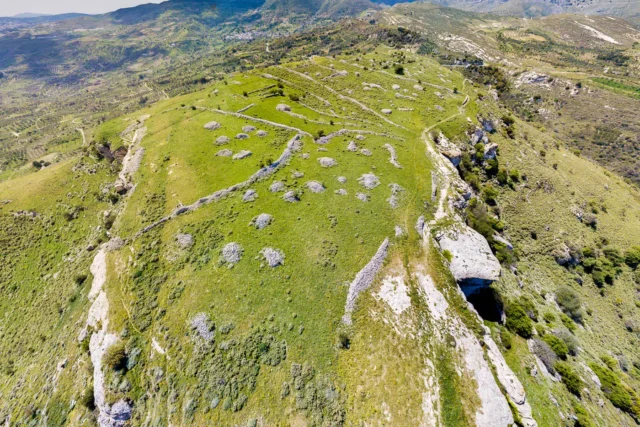
Ancient Rizinia
Rhizenia, also known as Prinias, was a city in central Crete during the Late Minoan IIIC period (around 1200 BC). Located on the Patela plateau, it held a strategic position overlooking key communication routes. Rhizenia likely played a crucial role in the region's political and economic landscape. The necropolis of Siderospilia has revealed much about burial practices and social structures of the time. The city's political system was unique, possibly incorporating both aristocratic and democratic elements. Archaeological investigations have revealed insights into urban layout, religious practices, and daily life. Imported artifacts from Cyprus and Egypt underscore Rhizenia's integration into a wider network of exchange during the Early Iron Age.
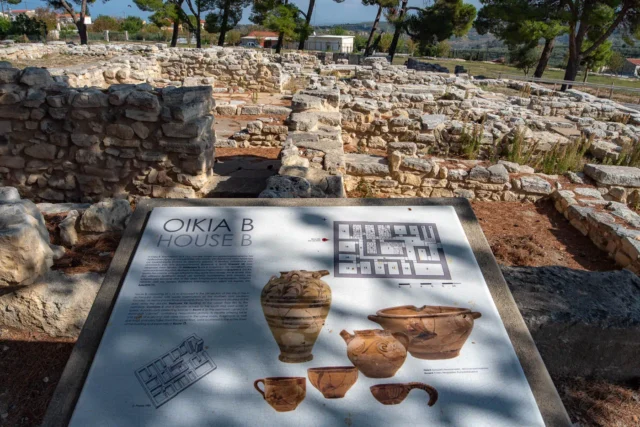
Ancient Tylissos
8:30 am - 3:30 pm
Tylissos, an ancient Minoan town located on the slopes of Mount Psiloritis in Crete, thrived between 1650 and 1200 BC. The town's strategic location on a major Minoan road contributed to its prosperity. Excavations have revealed three grand palaces (Megaron A, B, and C), showcasing remarkable Minoan architecture. Megaron A, the best-preserved, features a central courtyard, apartments, and storage rooms.
Significant finds include bronze cauldrons, a bronze figurine, Linear A tablets, and miniature frescoes comparable to those found in Knossos. These discoveries suggest Tylissos was a center for bronze working and played an important role in the Minoan civilization. Numerous tombs dating back to 1400-1200 BC have also been unearthed, containing painted sarcophagi, vases, jewelry, and seals, offering further insights into Minoan burial practices and culture.

Anemospilia
Anemospilia, a Minoan archaeological site on Mount Juktas in Crete, offers a unique glimpse into Minoan religious practices and beliefs. Discovered in 1979, the site features a rectangular building with four rooms, destroyed by an earthquake in the 17th century BC. The eastern chamber contains remnants of a stepped altar with offerings, fragments of pithoi with traces of food, and reconstructed vessels depicting religious ceremonies. The vestibule housed a crushed skeleton and numerous vessels. The central chamber contains a stone altar, believed to be the base of a life-sized wooden statue, with traces of vessels and a box containing a piece of rock symbolizing the earth. The western chamber contained three skeletons, including a young man found on a platform with a decorated knife, leading to interpretations of human sacrifice.

Apesokari Tholos tombs
The Apesokari Tholos Tombs in Crete are significant Early Minoan burial sites. Tholos Tomb A features a unique circular burial chamber and annex, used for both primary and secondary burials. Tholos Tomb B includes multiple rooms with evidence of communal drinking and larnax burials. Both tombs offer valuable insights into Early Minoan funerary practices and social organization.

Chersonissos, Herronissos (Ancient)
Chersonissos is an ancient Greek city located on the northern coast of Crete. It was inhabited as early as the Minoan period and continued to flourish under the Romans and Byzantine eras. The city served as the port of Lyttos, an inland city, and was an important center for trade and commerce. Archaeological excavations have revealed a number of significant structures, including a theater, early Christian basilicas, and harbor remains. The city's history is reflected in its coins, which feature various deities and symbols. Chersonissos is now a popular tourist destination, known for its beautiful beaches, ancient ruins, and lively nightlife.

Dafnes, Heraklion
Dafnes, a village in Heraklion, Crete, is known for its wine and olive oil production since the 13th century.
Dafnes is derived from the laurel plant (δάφνη - dafni).
The village is believed to have been founded by residents of another village named Skilochorio. Dafnes and Skilochorio are mentioned in documents from the 13th century.
Dafnes is known for its production of raisins, grapes, wine (using the Liatiko grape variety), and olive oil. The village has four wineries.
The village square hosts the annual Dafnes Wine Festival, usually held in the first ten days of July.

Episkopi, Chersonissos
Episkopi, a village near Heraklion, Crete, has a long history dating back to the Minoan era. The village's name, meaning "bishopric", reflects its role as the seat of the Bishop of Hersonissos after the Byzantine era. It has numerous Byzantine and post-Byzantine churches, including the 11th-century Panagia Kera-Limniotissa and the 14th-century Agios Ioannis with Venetian-era frescoes. Episkopi also has a war museum and a municipal park.

Festos (Phaistos)
8:00 am - 8:00 pm
Phaistos, a significant Minoan city in Crete, second in importance to Knossos, located in the Messara Plain. It dates back to 4000 BCE with a palace built in 1900-1700 BCE. The city was destroyed by an earthquake around 1700 BCE and rebuilt with a larger palace. Phaistos had connections with Knossos, Hagia Triada, and Gortyn. Important findings include the Phaistos Disk, Kamares Ware, and architectural remains. After a decline, Phaistos was reoccupied in the Hellenistic period (c. 323-67 BCE) until conquered by Gortyn.
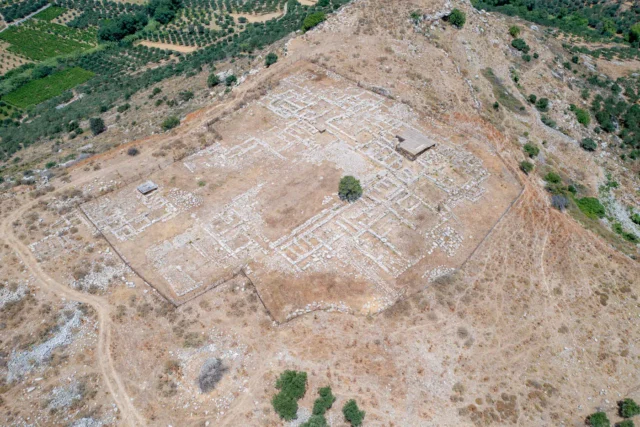
Galatas Minoan Palace
Galatas Palace, located in the Pediada region of central Crete, offers unique insights into Neopalatial Minoan architecture and sociopolitical organization. The palace, dating back to the Middle Minoan IIIB/Late Minoan IA period, covers approximately 1 hectare. Excavations completed in 2005 revealed evidence of a thriving town existing on the hillside during the Old Palace period. The West Wing housed centrally controlled activities like large-scale grain grinding and ceremonial feasting, while the East Wing, particularly the Pillar Hall and Column Hall, appears designed for social gatherings. In the Late Minoan IA period, Galatas experienced a decline with sections of the palace abandoned, indicating a shift in the palace's functions and the region's sociopolitical landscape.
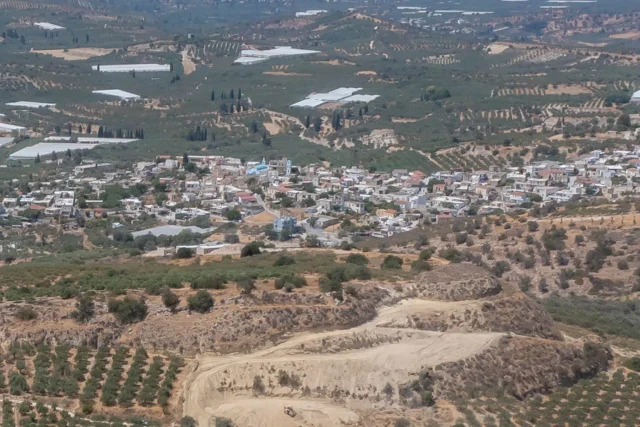
Galia, Phaistos
Galia, a Greek village in the Municipality of Phaistos, Heraklion, Crete, has a history rooted in the Venetian era, with its name derived from the Greek word for "milk." Recorded in 1577, it faced depopulation during the Turko-Egyptian rule (1834), with residents returning around 1870. After 1920, people from Vorizia boosted its population, peaking at 1,029 in 1961. The 2011 census showed 916 residents. Located on the Messara plain's northern edge, 5 km northwest of Moires and 57.3 km from Heraklion, its strategic position contributed to its agricultural prosperity. Today, it's known for vegetable cultivation, olives, livestock, and beekeeping. Amenities include shops, cafes, tavernas, a kindergarten, a primary school, and the central church of Agios Georgios.

Geraki, Minoa - Pediada
Geraki, or Gerakion, is a village in the Municipality of Minoa Pediada, Heraklion, Crete. It sits on the western slopes of Mount Sarakeno in the Dikti mountain range. The name Geraki is thought to originate from the first settler, Gerakis, documented in the Ducal Archives of Chandax in 1394. The village's economy is based on agriculture, including olive oil, raisins, grapes, and cereals, along with livestock. Notable landmarks include the Church of the Synaxis of the Archangels Michael and Gabriel, known for its frescoes, and the Geraki Gorge, a site of natural beauty with a history connected to the 1867 revolution. The neighboring village of Armacha belongs to the same Community. Geraki has appeared in censuses since 1583 and has a fluctuating population, currently around 254. It remains an active village with a primary school and a cultural association.

Gerokampos Tholos Tomb
The Lebena Gerokampos Tholos Tomb is an Early Minoan I-II (c. 3100-2600 BCE) archaeological site located near Lentas, on the southern coast of Crete, close to the ancient Minoan settlement of Lebena. The tomb, with an interior diameter of approximately 5 meters, is typical of tholos tombs, with a circular chamber built of large stones and a corbelled vault. The tomb also features several smaller chambers or annexes, which were added later. These annexes, along with the main tholos, served as spaces for burial and ritual activities. A large quantity of pottery, including pyxides, tankards, cups, and bowls, was found in the tomb. The tomb contained the skeletal remains of numerous individuals, providing evidence of collective burial practices. Other significant finds from the tomb include jewelry, tools, and figurines.
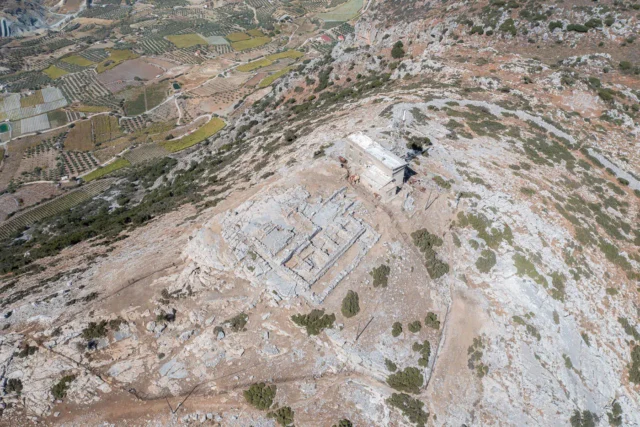
Giouchtas Minoan Peak Sanctuary
The Giouchtas Minoan Peak Sanctuary, located on the mountain of Giouchtas near Epano Archanes in Crete, is an archaeological site dating back to the Early Bronze Age. The site is associated with Minoan religion and offers insights into the ritual practices and beliefs of the Minoan civilization. Archaeological investigations have revealed structures, including a temenos, and artifacts like clay figurines and pottery fragments. The sanctuary's location on a mountain peak is characteristic of Minoan peak sanctuaries, chosen for its association with the divine realm and visibility. The Giouchtas sanctuary is located near Knossos and Archanes, suggesting it played an important role in the religious and social life of the Minoan people.

Kainourgio Chorio, Chersonissos
Kainourgio Chorio, a historic village in Crete, boasts a rich history dating back to the Second Byzantine period. Despite its name, meaning "New Village," it has a long and storied past evident in its well-preserved landmarks. The village, located in the Municipality of Hersonissos, is nestled at an altitude of 220 meters. Kainourgio Chorio is home to the Foscolo Tower, a Venetian-era fortified residence that later underwent modifications during the Ottoman occupation. The village also houses the Church of Panagia and Agia Paraskevi, adorned with surviving fragments of frescoes from the Venetian period. The Venetian wine presses, some of the largest in Crete, stand as a testament to the region's historical wine production. The Wine Museum, donated by Ioannis Papadakis, offers a glimpse into the region's winemaking heritage, showcasing preserved wine production facilities and a collection of wines.

Kalamaki
Kalamaki Beach, located on Crete's south coast near Kamilari, is a long stretch of golden sand facing Messara Gulf and Paximadia islets. Known for its relaxed atmosphere, the beach offers both organized areas with sunbeds and umbrellas, and secluded natural spots. However, the seabed composition can create strong winds, waves, and currents, requiring caution for young children and weak swimmers. While Kalamaki caters to various preferences, the southeast end transitions into the naturist-friendly Kommos Beach.
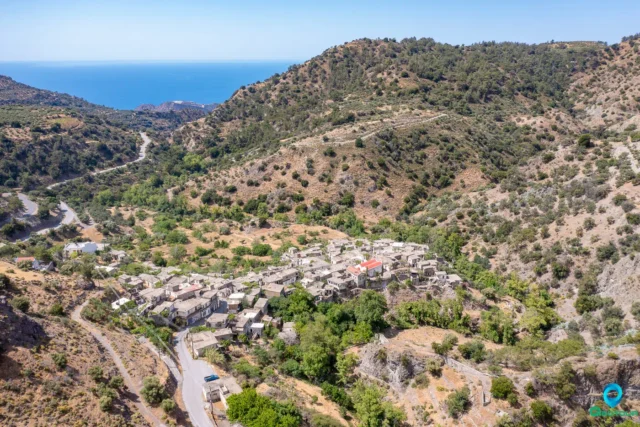
Kalami, Viannos
Kalami, a historic village in Crete, strategically located in the semi-mountainous area of the Viannos municipality. Built during the Venetian or Ottoman period, it offered protection against raids and pirate attacks. Once a thriving community, Kalami was an important commercial center with a customs office, warehouses, and various professions. The village's economy was based on agriculture, with residents cultivating olive trees, cereals, fruit trees, and carob trees. After 1960, the focus shifted to early vegetables and bananas. Kalami also served as the main winter residence, with people moving to lower-lying "metochia" in the summer for farming. Today, Kalami is largely deserted, with most residents relocating to coastal settlements.

Kamilari Roman graveyard
The Roman Tombs of Kamilari, located in southern Crete, are an archaeological site that offers a glimpse into the island's history during the Roman period. Discovered in 2010, the tombs are situated at the foot of Evgora Hill, close to Metochi Kamiliariou. The area was known locally as "Xospilios," possibly derived from the Greek word for cave ("spilaio"). The tombs are estimated to have been constructed around 50 AD, based on discovered coins, and provide valuable insights into Roman burial practices. The site is under the supervision of the Archaeological Service.
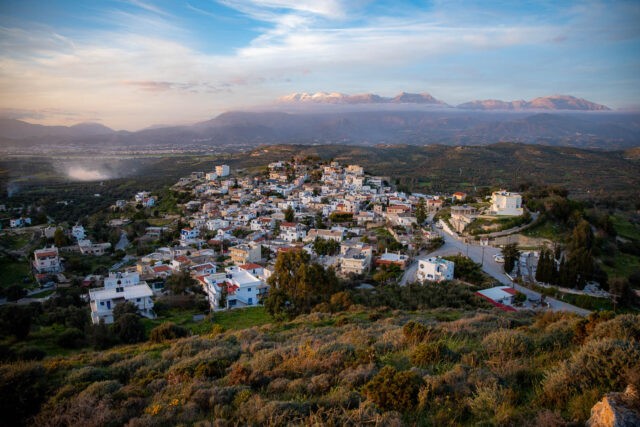
Kamilari, Phaistos
Kamilari is a village in the Asterousia mountains of Crete. Its history dates back to the Minoan era. The village's name, first recorded in 1370, is likely derived from the Byzantine family name "Kamelaris" or the term "Hamilon Oros," meaning "Low Mountain."
Kamilari is archaeologically significant, with nearby sites like the Minoan palace of Phaistos and the Kamilari Tholos Tomb. The discovery of a bothros containing terracotta figures from the Geometric period confirms the area's long history of human presence.
The village's Cultural Association works to preserve local traditions and customs. Kamilari offers a unique experience for visitors to Crete.

Karfi archaeological site
Karphi, a Late Minoan IIIC refuge village in Crete, perched high above the Lasithi Plateau, offers a glimpse into Minoan resilience during a time of upheaval. Excavated in the late 1930s, the site reveals a planned settlement with houses, streets, and evidence of diverse cult activities. Its strategic location provided a defensive advantage, offering panoramic views of the Lasithi plain and north-central Crete. The village likely served as a refuge for Minoans seeking safety and survival after the collapse of the Minoan palaces. Despite the harsh conditions, the village featured paved streets, yards, and single-story houses, suggesting a planned and organized community. Karphi stands out for its diverse and widespread cult activities, with shrines dedicated to goddesses and various ritual artifacts. The Temple served as the central focus for ritual activities, housing goddess figures, snake tubes, braziers, and fireboxes. Other areas, such as the Commercial Quarter and the Great House Shrine, also contained evidence of cult practices. Rooms containing offering stands, figurines, and libation vessels indicate that rituals were not confined to formal shrines, suggesting a more informal setting for community offerings. This decentralized approach to ritual practices distinguishes Karphi from other LM IIIC sites.
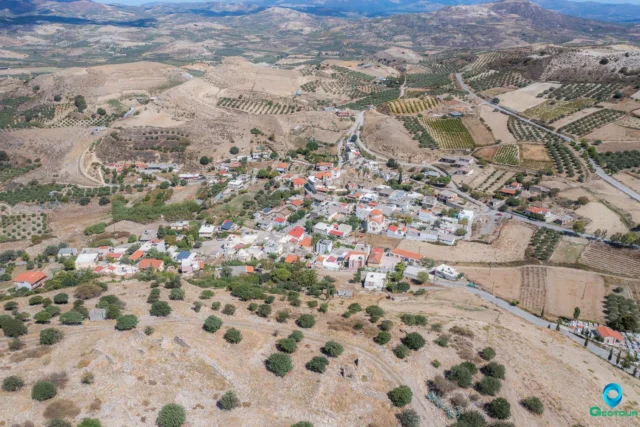
Kastelli (Tsifout Kastelli), Gortyna
Kastelli, also known as Tsifout Kastelli (Jewish Castle), is a village in Ano Akria, Heraklion, Crete. It is 7 km north of Asimi and 44 km from Heraklion, at an altitude of 448 meters. The village, historically linked to the 13th-century Castel Bonifacio, is mentioned in documents from 1375 and 1583. Residents mainly engage in olive cultivation and livestock farming. Points of interest include the ruins of Castel Bonifacio and the Church of Constantine and Helen, which celebrates its feast day on May 21st. The village has seen a steady population with recorded numbers from 1881, 1900, 1928, 1981, 1991, 2001, 2011, and 2021.

Kato Symi, Viannos
Kato Symi is a village nestled in a fertile valley within the Viannos municipality, Heraklion, Crete. The village is surrounded by a mountainous area with the largest forest cover in the region, including the Symi forest, and the Blavopotamos river flows through it. Known for its natural beauty, the valley boasts numerous fruit trees and caves like Zymbraga Spiliaria and Kissospilios. Kato Symi is also rich in history, with significant Minoan-era archaeological finds, particularly the neo-palatial sanctuary of Hermes and Aphrodite at Krya Vrysi, dating back to 2,000 BC. The village has several notable churches, including the Church of the Panagia Galatoktismeni and Nistikoktismeni, built in 1385, and the Church of Agios Georgios with frescoes from the mid-15th century. Kato Symi has a long history, mentioned in the 1583 census as "Simi Catto." It was a site of resistance during the Ottoman period and World War II, where residents bravely fought against German forces. The village's population has declined over the years, but its historical significance and natural beauty remain.

Kato Viannos, Viannos
Kato Viannos, located in the foothills of Mount Dikti on the island of Crete, is a historic village with a history dating back to at least 1583. The village is home to several notable churches, including the Church of Agios Georgios and the Church of the Presentation of the Virgin Mary. During World War II, the village and its residents suffered greatly under Nazi occupation, with mass executions and the destruction of homes. Despite this tragic history, Kato Viannos remains a resilient community with a rich cultural heritage.

Klima, Phaistos
Klima village, in Crete's Amari Valley, has a history dating back to the Venetian period. Located 70 kilometers from Heraklion, it was part of the Rethymno district during the Ottoman period and became part of the Heraklion prefecture after 1913. Agriculture is central to village life, with olive groves, vineyards, and sheep and goat herding.
The village has a rich cultural heritage, with a strong Cretan identity expressed through dialect, music, and dance. The "Kritikos" dance is popular at festivals and weddings. Religion is also important, with the Assumption of the Virgin Mary celebrated on August 15th.
Family and community are central to village life, with strong kinship ties and shared responsibility. Traditional gender roles are observed, but there is also a strong sense of community spirit, evident in the tradition of offering labor for communal projects.

Knossos archaeological site
The Palace of Knossos, located on the Kephala hill south of Heraklion, Crete, is an important site of the ancient Minoan civilization. Occupied since around 7000 BCE during the Aceramic Neolithic period. The First Palace, built during the Middle Minoan IB-IIA period, represents a significant shift in Minoan society from a clan-based structure to a hierarchical one. This monumental building, covering nearly 10,000 square meters on the ground floor alone, served as a hub for administrative, storage, and cult activities. The First Palace also introduced innovative features like storage magazines, showcasing the society's wealth and resources. The New Palace emerged after a massive earthquake that occurred at the end of the Middle Minoan IIIA period, the palace underwent major reconstruction in the Middle Minoan IIIB period. Around 1450 BCE, widespread destruction occurred across Crete, affecting palaces and settlements. While Knossos suffered damage, it wasn't destroyed like other palaces. This period saw the introduction of Linear B, an early form of Greek script used by the Mycenaeans, suggesting their presence at Knossos. The final destruction of the palace, possibly in Late Minoan IIIA2 (1325-1300 BCE), left it deserted, but the town continued to exist. Knossos continued to be inhabited during the Classical, Hellenistic and Roman periods. Two basilicas from the First Byzantine period indicate that the city was still active during this time. Knossos appears to have followed the fate of other urban centers in Crete and declined early.
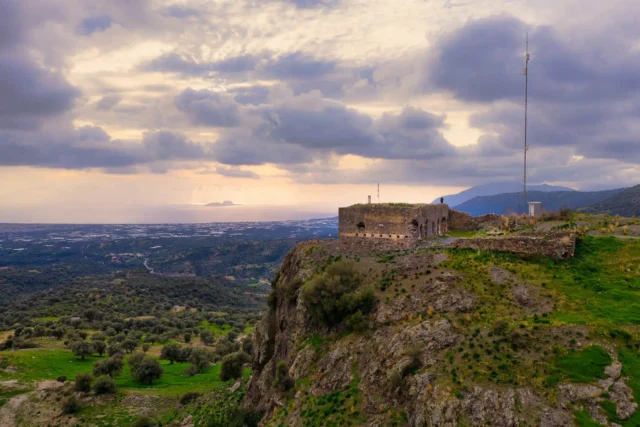
Koules in Magarikari
The Koules of Grammeni, also known as the Koules of Grigoria or Magarikari, is an Ottoman fortress in Crete, Greece. Built in the late 19th century during the Great Cretan Revolution (1866-1869), it was strategically positioned between the villages of Grigoria and Magarikari overlooking the Messara Plain. Measuring 25 meters by 11 meters, with 24 embrasures, it was used as a stronghold by the Ottomans to maintain control over the rebellious Cretan population. In May 1944, it provided refuge to the villagers of Magarikari during the German occupation. Today, the Koules of Grammeni stands as a well-preserved reminder of Crete's turbulent past and the island's enduring spirit.
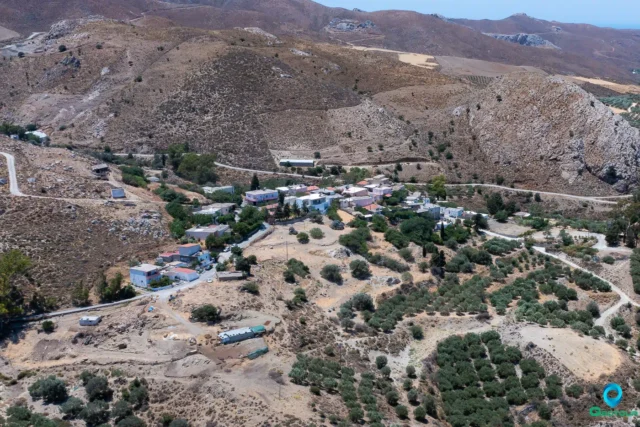
Koumasa, Gortyna
Koumasa, a Cretan village with a long history, is located in the Gortyna municipality on the foothills of the Asterousia Mountains. It is known for its archaeological sites, including tombs and settlements from various Minoan periods.
The village's history dates back to at least 1368 during the Venetian period. The name "Koumasa" likely comes from the word "koumos," meaning a temporary shelter for animals.
A research program led by Professor Diamantis Panagiotopoulos is currently excavating and studying the settlement and necropolis. Discoveries include a Pre-palatial and Old Palace period necropolis, a New Palace period settlement, and an Early Minoan underground burial deposit.
With 69 inhabitants, Koumasa maintains a tranquil atmosphere. The village continues its agricultural traditions, while the archaeological research attracts visitors.
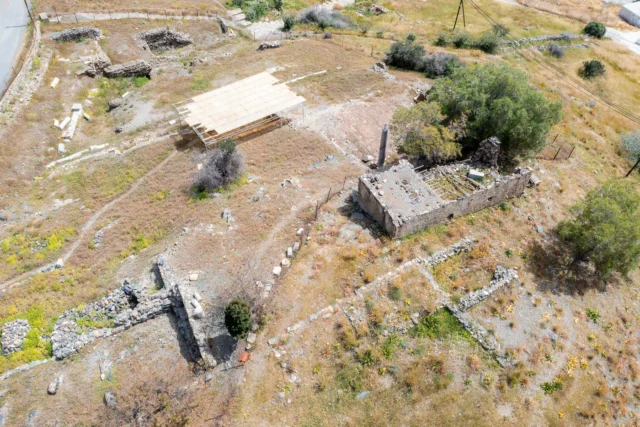
Lebena (Leveen)
Lebena, an ancient city on Crete's southern coast, is renowned for its Sanctuary of Asclepius, the Greek god of medicine. The city's strategic location near a good harbor and its association with the healing cult of Asclepius made it an important center for both trade and religious pilgrimage. Lebena was also a significant port for trade and commerce with the East during the Prepalatial period. The site of Lebena has a long history of occupation, with evidence of inhabitation dating back to the Neolithic and Early Minoan periods (ca. 3rd millennium BC). The presence of a variety of Eastern imports in secure Prepalatial contexts at Lebena, including faience, gold, ivory, and Egyptian scarabs, suggests that Lebena was a significant port for trade and commerce with the East during this time. In the Late Classical period (ca. 4th century BC), the Gortynians established the sanctuary dedicated to Asclepius at the harbor. The city was destroyed by a powerful earthquake in 46 BC but was subsequently rebuilt. The sanctuary continued to flourish throughout the Roman period, as evidenced by the numerous inscriptions and archaeological finds from the site. The strategic location of Lebena on the south coast of Crete made it an ideal location for a port. The sheltered bay would have provided a safe harbor for ships, and the proximity to the Asterousia Mountains would have offered protection from storms. Additionally, Lebena's location on the south coast would have made it a convenient stopping point for ships traveling between the Aegean and the Near East. The presence of Eastern imports at Lebena suggests that the site was an important point of contact between Crete and the East during the Prepalatial period.

Lefkochori, Minoa - Pediada
Lefkochori, formerly Voutoufou, is a semi-mountainous village in the Heraklion Regional Unit on the island of Crete, Greece. The name "Lefkochori" translates to "white village," adopted in 1955 due to the abundance of poplar trees. Byzantinologist Periandros Epitropakis suggests the older name "Voutoufou" is Frankish for "peak of fire," indicating the village may have been used as a beacon. Historical churches include the Church of Agios Georgios and Agios Ioannis, the Church of Panagia, and the Church of the Metamorphosis of the Savior with 13th-century Byzantine frescoes. The area has interesting toponyms like Sarakina, Belvedere, and Foresi.

Lentas, Gortyna
Lentas is a small, tranquil village on Crete's south coast, in the Heraklion region. It is located 74 kilometers southwest of Heraklion city. In ancient times, Lentas was the site of Levin, a significant port and sacred site. Levin was a major center for the worship of Asclepius, the god of healing. The ruins of the Asclepieion, a temple dedicated to Asclepius, can still be seen today. Excavations have also revealed a Protominoan settlement dating back to 2500-1900 BC. The name "Lentas" is thought to be pre-Hellenic, possibly derived from the Phoenician word for "lion" or the ancient word "Levynthos." The village is known for its beautiful beaches, including Lentas beach, Dytikos, Tsigounas, Loutra, and Trafoulas. Dytikos beach is known for its relaxed atmosphere and association with the hippie movement.
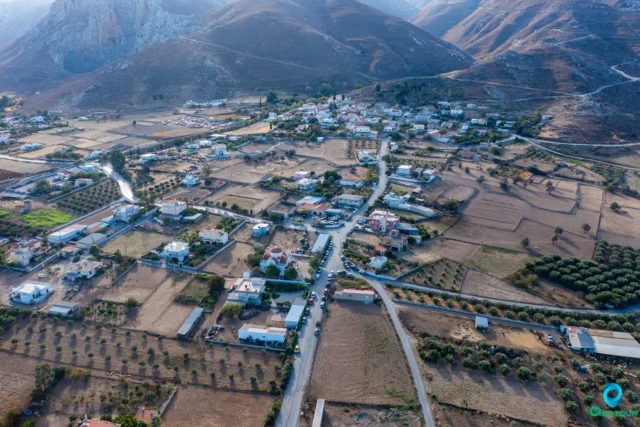
Loukia, Gortyna
Loukia, located in the Asterousia Mountains of Crete, is a village with a rich history dating back to at least 1368. Records indicate its existence under both Venetian and Ottoman rule. The village, situated 67 kilometers south of Heraklion, has a population of 155. Loukia features traditional architecture, some of which is in disrepair. Despite its small size, the village maintains a primary school, churches, and a cultural association dedicated to preserving its heritage.
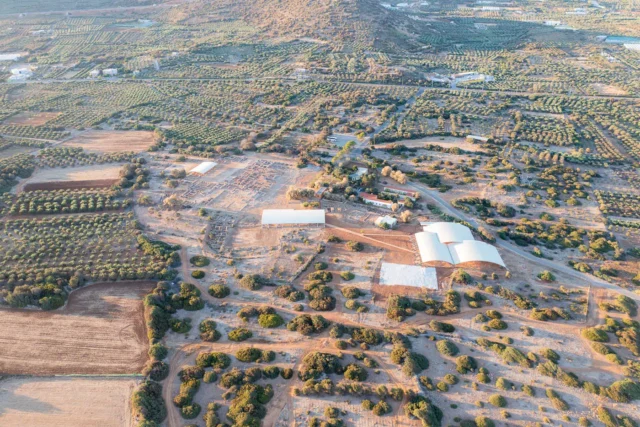
Malia Minoan Palace
8:00 am - 6:00 pm
The Minoan archaeological site at Malia, located on the northern coast of Crete, is a significant site for understanding the Bronze Age civilization. The Palace of Malia is the third largest Minoan palace discovered. The palace and surrounding town and cemeteries offer a glimpse into the complex social, political, economic, and religious structures of Minoan society. The area was inhabited as early as the Early Neolithic period. The first monumental architecture at Malia, often referred to as the Old Palace, dates to the Early Minoan IIB period. This structure, or group of structures, was built around a large open space, sharing the same alignment as the later palace. The second palace, whose ruins are visible today, was built in the Late Minoan IA period, around 1650 BCE. It was constructed on the ruins of the Old Palace, inheriting its basic layout and orientation. The palace's central court, a defining feature of Minoan architecture, is oriented north-south. The New Palace at Malia met its demise around 1450 BCE, coinciding with the destruction of other Minoan sites across Crete. The cause of this widespread destruction remains a topic of scholarly debate.

Mana Elia, ancient olive tree
The Monumental Olive Tree, or “Mana Elia,” is a 2,800-year-old olive tree located in Kamilari, Crete. It has been designated a natural monument due to its size and historical significance. The tree has a base perimeter of 9.5 meters and its trunk is marked by age. The Kamilari Cultural Association has placed twelve large stones around the tree for protection. Eight of the stones are carved with the double axe symbol associated with the Minoan civilization. Mana Elia is near the Kamilari Tholos Tomb and the Minoan Palace of Phaistos. It is a “Thrombolia” variety olive, locally called “Hontrolia,” grafted onto a wild olive rootstock. This grafting technique ensures the tree’s continued health. Mana Elia is a popular tourist attraction and represents Crete’s history of olive cultivation. It is valued for its historical and cultural significance.
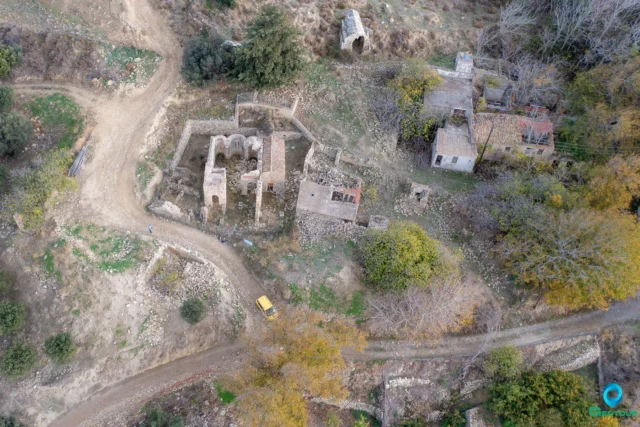
Mikra Episkopi
Mikra Episkopi is an abandoned village in Crete, Greece. Once known as the seat of the Diocese of Arcadia, it is now deserted with dilapidated houses and overgrown paths. The village is located 7 km southwest of Arkalochori and 1 km north of Partira. Despite its current state, Mikra Episkopi holds historical significance, particularly due to the ruined church of Sotiras Christos (Savior Christ), a Venetian-era structure built upon the remains of an earlier basilica. The church features a cruciform architectural style with a dome and a narthex, with some walls, columns, and capitals still visible. Additionally, the village has the church of Panagia (Virgin Mary) with Venetian-era frescoes and the ruins of the church of Agios Dimitrios (Saint Demetrius).
The population of Mikra Episkopi has dwindled over the centuries, from a mix of Christians and Muslims in the 1800s to becoming completely abandoned in the 1990s. Recent census data shows a slight increase in population, but the village remains largely deserted.

Minoan Palace of Epano Archanes
The Minoan Palace of Epano Archanes, also known as the Tourkogeitonia Palace, is a significant archaeological site located in the village of Epano Archanes on the island of Crete, Greece. This palatial complex dates back to the Neopalatial period of the Minoan civilization (around 1700-1450 BC). It is smaller than the palaces of Knossos, Phaistos, and Malia, but boasts a unique architectural layout with multiple wings and levels, and impressive features including an elaborate drainage system. The palace likely played a crucial role in the economic and religious life of the surrounding community. Excavations at the site have unearthed a wealth of artifacts, including pottery, tools, figurines, and seal stones, shedding light on the daily life, artistic traditions, and religious practices of the Minoans. A recent discovery in 2024 unearthed a unique Gate Shrine located outside the main entrance, the first of its kind at a Minoan palace, shedding new light on the religious practices and beliefs of this ancient civilization.

Moires, Phaistos
Moires is a modern town located in the fertile Messara plain of Crete, approximately 38 kilometers southwest of Heraklion. The town has a rich history, potentially dating back to the Venetian era, and has experienced significant growth over the centuries. Moires is a bustling hub of activity, known for its agricultural production, particularly olive oil and wine, and its vibrant Saturday market, the largest in Crete. The town also serves as an administrative center and offers a range of amenities, including schools, banks, and a health center. Its strategic location provides easy access to key attractions such as the Minoan palaces of Phaistos and Agia Triada, the Roman ruins of Gortyna, and the coastal areas of Matala.
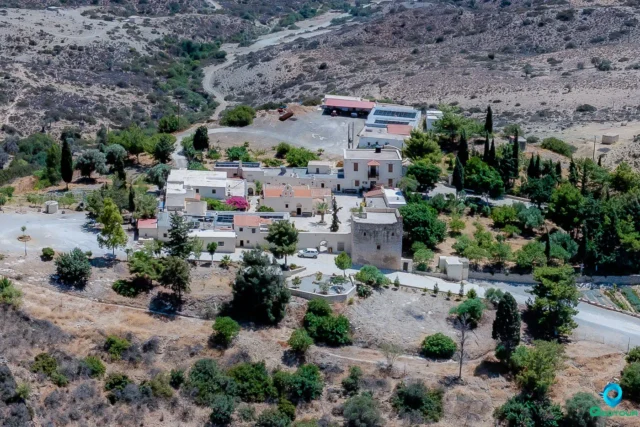
Moni Odigitrias monastery
Moni Odigitrias, a 14th-century Greek Orthodox monastery nestled in the Asterousia Mountains of Crete, stands as a testament to the island's rich history and resilience. Dedicated to the Virgin Mary "Odigitria" ("She who shows the way"), the monastery has been a place of pilgrimage and refuge for centuries.
During the Venetian period, Moni Odigitrias flourished as a center of learning and art. Its walls are adorned with frescoes by renowned Cretan painters, including Angelos Akotantos, who also crafted the monastery's iconic iconostasis. The monastery's collection of valuable icons and manuscripts further reflects its cultural significance.
Moni Odigitrias played a pivotal role in the Cretan resistance against the Ottoman Empire. It served as a sanctuary for rebels and a symbol of defiance. The legendary "Xopapas" (Father Ioasaph), a monk turned rebel leader, led the resistance from within the monastery's walls.
Today, Moni Odigitrias remains a working monastery, home to a small community of monks. It has undergone extensive restoration and welcomes visitors to explore its historic grounds, including a museum showcasing artifacts from its past. The museum houses a traditional loom, a stone oven, an olive press, and agricultural tools, providing a glimpse into the monastery's self-sufficient lifestyle.
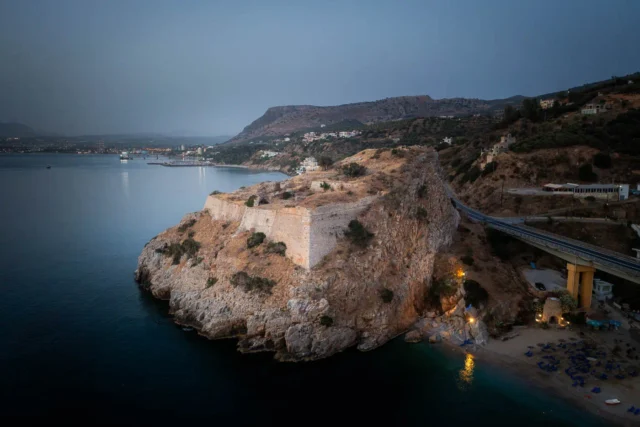
Palaiokastro Fortress: Guardian of Heraklion Bay
The Palaiokastro Fortress, built by Venetians (1573-1595) on a cliff overlooking Palaiokastro Beach near Heraklion, Crete, defended Heraklion Bay. Its three levels housed powder magazines, a cistern, barracks, and a chapel. The winged lion of St. Mark on its walls signifies Venetian heritage. Captured by Ottomans in the Cretan War (1645-1669), the fortress was documented in the 1900s by G. Gerola. Now partly ruined, it's undergoing restoration.
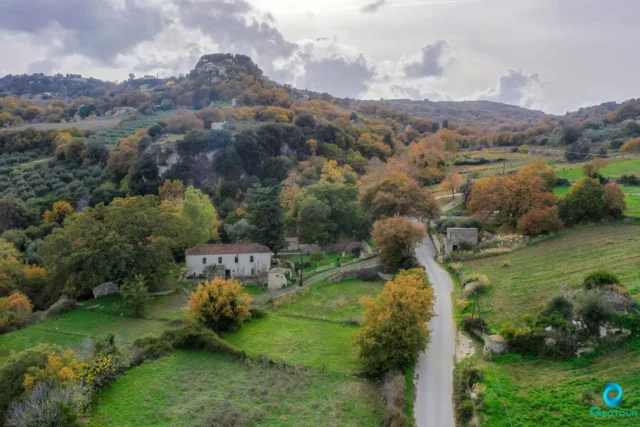
Panagia Kardiotissa in Agios Thomas
Panagia Kera Kardiotissa, a 14th-century Byzantine monastery near Agios Thomas in Crete, is dedicated to the Nativity of the Virgin Mary. Located in a lush landscape at an altitude of 630 meters, the monastery is situated in a place called Mouzouras, next to the Axedianos River. The monastery once housed a miraculous icon of Panagia Kardiotissa, depicting the Virgin Mary holding Christ. The icon's origins are debated, with some attributing it to an Armenian monk named Lazarus and others to the Heraklion painter Andreas Ritzos. The icon's miraculous powers were documented as early as 1415. The monastery became a significant pilgrimage site in 1912 following a vision of the icon of Saint George. It served as a nunnery from 1935 to 1962 and sheltered residents during the German occupation. Today, the renovated site features a centuries-old oak tree, peacocks, and a workshop for traditional weaving.

Panorama, Minoas - Pediada
SEO from existing text
Custom Gem
Panorama, formerly Gournia, sits at the foot of Gurniani Korfi hill in Crete, 29.5 kilometers from Heraklion, and offers magnificent views. Records suggest it may have been a Venetian fief, evidenced by a coat of arms in the church of Agios Georgios. During the Ottoman period, it was mainly a Muslim village. After the Asia Minor Disaster, Greek refugees settled there, embracing local customs and focusing on agriculture, especially viticulture. The village has churches like Agios Georgios, Agios Fanourios, and Agia Marina. The name "Gournia" likely came from the small basins at the village spring. Historical accounts mention a Byzantine church, possibly Agios Georgios Styronas. The village relied on agriculture, producing grapes, raisins, olive oil, and cereals. Viticulture remains important to the local economy. "Panorama" was adopted in 1951 due to the village's stunning views. Local legends speak of caves with hidden treasures.
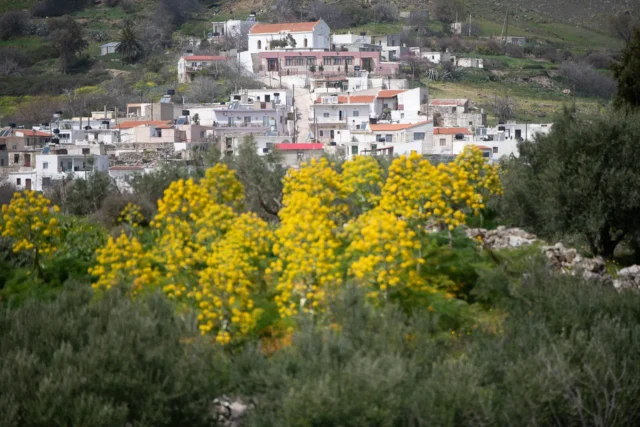
Paranymfoi, Archanes - Asterousia
Paranymfoi is a small, picturesque village nestled in the Asterousia Mountains of Crete, with a history stretching back to the 13th century. The village is mentioned in Venetian records and Ottoman censuses, bearing testament to its long history. The rugged terrain has contributed to a strong sense of community and self-reliance among its inhabitants, who have traditionally been involved in agriculture and animal husbandry.
Paranymfoi's strategic location made it an important stopover for travelers and traders in the past. Today, it continues to attract visitors with its stunning panoramic views, which include the Libyan Sea. The village also serves as a starting point for exploring the Asterousia Mountains, offering a unique blend of natural beauty and historical significance.
A small folklore museum, established by the local cultural association, showcases the traditional way of life in the region. The museum houses a collection of old objects used in weaving, storage, agricultural work, and various household items. The church of Agios Pavlos, with its remnants of frescoes, stands as a reminder of the village's rich past. Paranymfoi's enduring presence and unique character make it a hidden gem in the tapestry of Cretan history.

Petrokefali, Phaistos
Petrokefali, a village in the Municipality of Phaistos, Crete, has a long history, dating back to Venetian censuses where it was recorded as Petrochieffali. The village is located at the 59.3rd kilometer of the road to Matala. In 2021, its population was 813. The inhabitants are mainly engaged in agriculture, particularly olive growing and the cultivation of citrus fruits and early vegetables. Historically, the area was also known for rice cultivation. Petrokefali has a Cultural Association of Ladies, an Adult Education Center, a kindergarten, and a primary school. The village is also known for its connection to the Cretan Revolution against the Ottomans, particularly through figures like Michael Kourmoulis and Xopateras. The abandoned village of Flambanochori, located south of Petrokefali, is believed to have been deserted due to the devastating plague of 1592.

Platanos Minoan tholos tombs
The Minoan tholos tombs at Platanos, located in the Messara Plain of Crete, are significant archaeological remains from the Prepalatial period (c. 3200-2000 BC). Excavated in the early 20th century, the site features three tholos tombs (circular, beehive-shaped burial chambers) and a paved courtyard. The tombs, labeled A, B, and C, vary in size and preservation. Tomb A, the largest, has an internal diameter of 13 meters. The tombs contained many artifacts, including seals, figurines, pottery vessels, stone vessels, gold jewelry, and bronze tools. These findings provide valuable insights into Minoan funerary practices and material culture during the Prepalatial period. The presence of imported objects, such as an ancient Babylonian cylinder seal and Egyptian scarabs, also highlights the extensive trade networks that connected Crete with other civilizations in the Eastern Mediterranean.
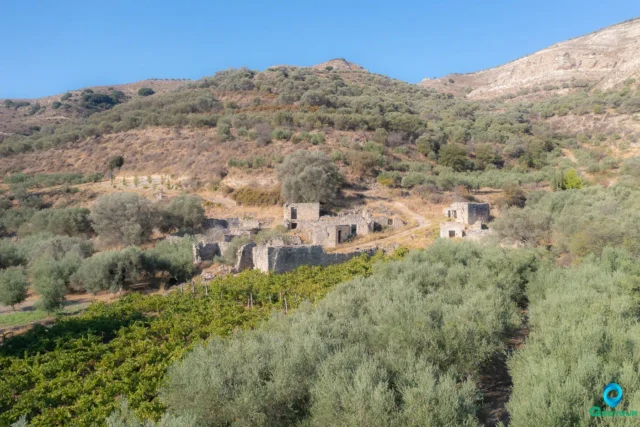
Psalida abandoned village
Psalida (Ψαλίδα), an abandoned village in Gergeri, Crete, offers a glimpse into the island's past. Dating back to the 16th century, the village was once home to farmers, as evidenced by animal feeders found in the ruins. Historical records from 1583 mention Psalida as a dependency of Gergeri with 60 inhabitants. Today, only the stone houses remain, standing as a testament to the traditional way of life. Psalida's location provides stunning views of the surrounding countryside. The village is a reminder of Crete's rich history, including the Greek War of Independence and conflicts between the Christian and Muslim populations.
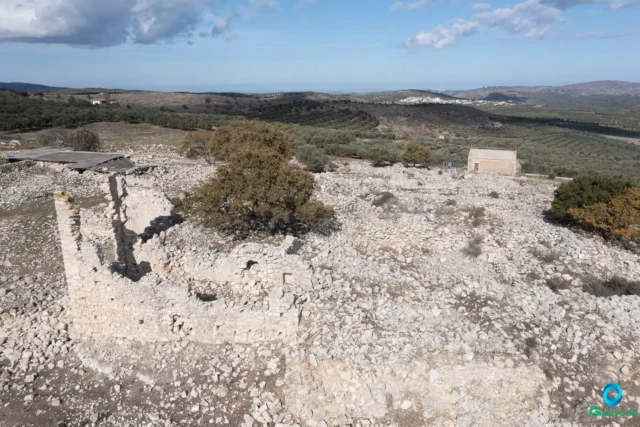
Rouma abandoned village near Alagni
Rouma, a deserted village east of Alagni in Crete, takes its name from the Cretan word for "river stream." The village, formerly abundant in oak and pine trees, was abandoned after a plague outbreak. Survivors relocated to Alagni. Despite its abandonment, Rouma is remembered for the church of Panagia tou Roumatou (Virgin Mary of Rouma), a landmark that remains historically and religiously significant. A 1630 census recognized Rouma as a separate village. The restored church of Panagia tou Roumatou is a reminder of Rouma's past, with excavated sacred vessels further highlighting its history.
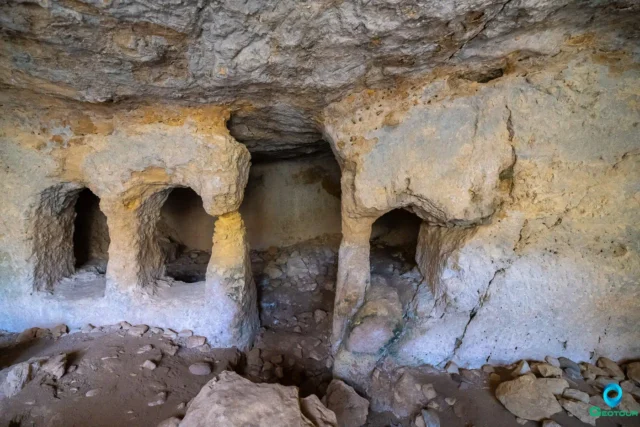
Siderospilia near Roufas
Siderospilia, meaning "Iron Caves," is a complex of three interconnected chambers carved into limestone bedrock near Roufas, Crete. Its purpose is debated, with theories ranging from blacksmith workshop to Roman-era burial site. Chamber 1 features a broken supporting column, roof opening, and stone bench. Chamber 2 is larger, with niches for burials. Chamber 3 resembles an early Christian church, with a dividing wall and door. Local legends link the cave to blacksmiths, ghosts, and eerie sounds. Some believe it was a dwelling before becoming a necropolis. The cave's location near a stream and possible ancient structures adds to its significance. Siderospilia is accessible but lacks official signage.

Skinias, Minoa - Pediada
Skinias, a village on the eastern slope of a hill, 51.4 km from Heraklion, Crete, has a rich history dating back to the Minoan era. The name 'Skinias' comes from the Pistacia lentiscus shrub, once believed to grow on the roof of the village church, Agios Antonios. Near the ancient city of Priansos, the area boasts archaeological findings from the Minoan, Hellenistic, and Byzantine periods. First documented in 1373, Skinias was under Venetian rule in 1583 and became part of the Monofatsi province in 1867. During the Turkish occupation, it remained solely inhabited by Christians. Today, the village relies on agriculture, producing olive oil, cereals, and raisins. With a kindergarten, primary school, gymnasium, and a cultural association, Skinias fosters a strong community spirit.

Sklavokambos
The Sklavokampos Farm Estate, a significant Late Minoan period archaeological site in Crete, Greece, offers a unique window into Minoan life. Discovered in 1930, the estate is located southwest of Heraklion, near Tylissos. The estate's strategic location near the Minoan road network and the fertile Messara Plain suggests it played a crucial role in agricultural production and trade. The estate's architecture is simpler than Minoan palaces, featuring 17 rooms across three levels. The site includes a main room with artifacts like a clay ox head, a Late Minoan IB jug, and a stone rhyton. Sealings from Sklavokampos have been found at other Minoan sites such as Zakros, Gournia, and Hagia Triada, indicating connections across Crete. The estate also housed a small shrine, storerooms for agricultural products, and a toilet with an underground drain. Evidence suggests the estate was part of a larger settlement destroyed by fire, possibly during the Late Minoan IB period.
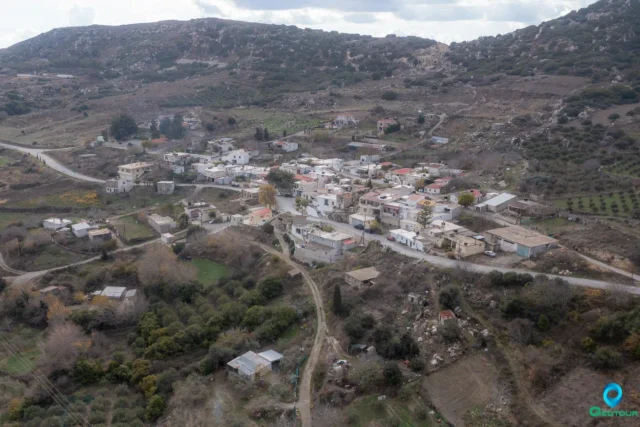
Steironas, Minoas - Pediada
Steironas, located on a hill, 10 km west of Arkalochori, Crete, has a history from the Venetian period, Ottoman rule, and Greek-Turkish population exchange. It's known for the Myragapi Traditional Folklore Rakokazano, showcasing traditional production of wine and tsikoudia, and the late Byzantine church of Panagia with frescoes and an icon of the Virgin Mary.
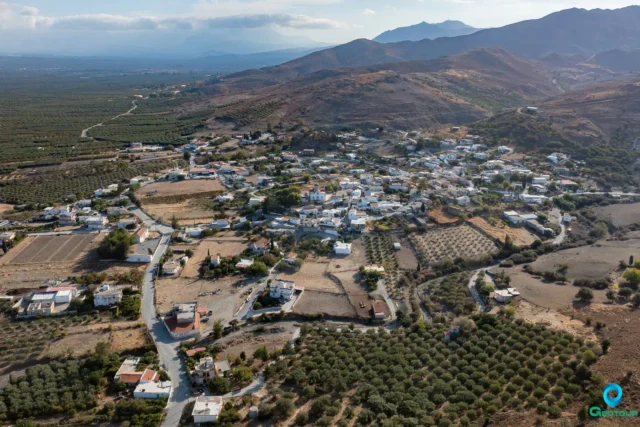
Sternes, Gortyna
Sternes, a village in Heraklion, Crete, has a history dating back to the 13th century. Its name comes from the Greek word "sterna," meaning cistern, referencing a large Roman-era cistern located west of the village.
Sternes is in the foothills of the Asterousia Mountains. The village has been documented in historical records as early as 1271. Today, Sternes remains an agricultural community with a population of around 420, focused on the cultivation of olives and grapes for raisins.
Sternes has several churches and chapels, including the church of the Presentation of the Virgin Mary, the church of Saint John, and the chapels of Agia Paraskevi and Panagia. The village also has a cultural association, a kindergarten, and an elementary school.
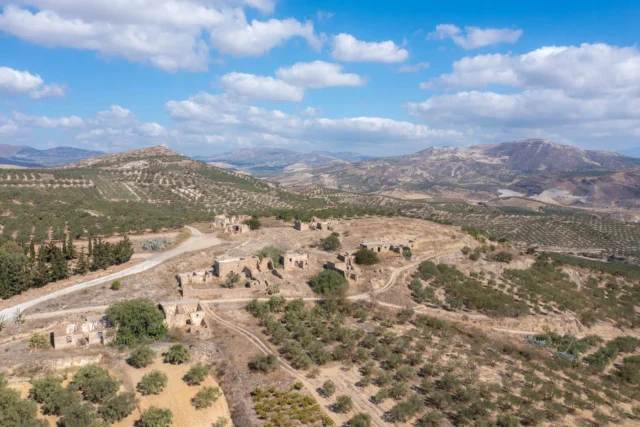
The Abandoned Village of Velouli near Apoini
Velouli, a deserted village 44 km south of Heraklion, Crete, boasts a 400-year history. Once inhabited by Cretan Muslims and Asia Minor refugees, it played a key role in WWII's Cretan resistance. The Valavanis family housed resistance figures like Podias, Petrakogiorgis, and the Bantouvas brothers. The village features the Byzantine church of Panagia Velouliani, with an inscription dating back to 1209. Though abandoned today, with residents migrating to Apoini, Velouli's deserted houses and resilient church stand as testaments to its rich past.
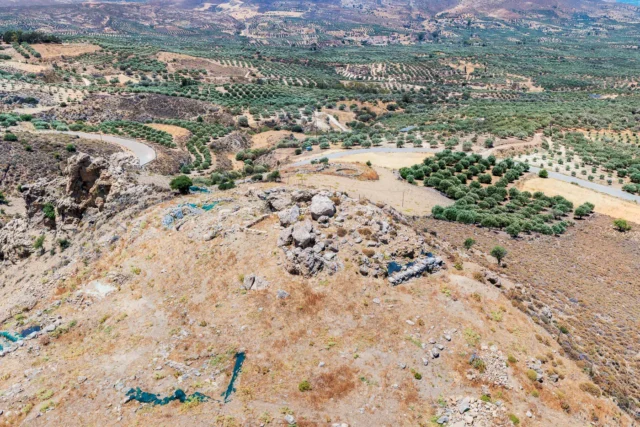
The Minoan Settlement and Cemetery at Koumasa
Koumasa, an important Minoan archaeological site in southern Crete, is located about 15 km south of Gortyn. The site is significant for its Prepalatial cemetery and Minoan settlement, providing insights into the lives and customs of the Minoans during the Prepalatial period.
The Cemetery at Koumasa consists of three circular tholos tombs, a square tomb, and a circular ossuary. Excavations uncovered artifacts, including a clay figurine depicting a bull-leaping scene, Cycladic figurines, stone offering tables, and gold jewelry.
The Minoan settlement at Koumasa is located on a hill overlooking the cemetery. Excavations have revealed an extensive settlement with evidence of domestic and industrial activities. The presence of large walls suggests the existence of substantial buildings.

The Necropolis of Phourni
The Phourni necropolis, near Archanes, Crete, is a significant Minoan burial site used from the Early Minoan II (EM II) to the Late Minoan IIIC (LM IIIC) periods. It features a variety of tomb types, including tholos tombs, rectangular tombs, and composite tombs, reflecting the evolution of Minoan funerary architecture and burial practices over time. Tholos tombs are beehive-shaped structures used for collective burials, while rectangular tombs resemble houses, suggesting a symbolic connection between the house of the living and the house of the dead. Composite tombs combine elements of both tholos and rectangular tomb architecture.
The necropolis has yielded a wealth of grave goods, including pottery, stone vases, metal objects, jewelry, and figurines, providing insights into the social structures and religious beliefs of the Minoans. The variety of tomb types and grave goods reflects the prosperity and social complexity of the Archanes valley. The architectural features and artistic motifs found at Phourni resonate with those found at Knossos, indicating cultural homogeneity and interaction between these two important centers. The religious beliefs of the Minoans are also reflected in the finds at Phourni, with religious symbols and ritual objects suggesting a belief in an afterlife and elaborate burial rituals.
The Phourni necropolis is the richest burial site in Crete and provides a unique glimpse into the burial practices, social structures, and religious beliefs of the Minoan civilization.

The Settlement of Vitsilia
Vitsilia, an abandoned medieval village in Crete, provides valuable insights into fortified settlements of the era. Located in Monofatsi, Heraklion, the village was inhabited by villeins and free peasants. A 1387 document reveals details about its structure, including a northern wall, two entrances, and two towers. The village, with a naturally fortified position, likely served as a watchtower in earlier times. Archaeological evidence suggests the presence of houses, a church, and a cemetery. Despite its small size, with a population never exceeding 60, Vitsilia holds historical significance. Today, five houses and the Venetian-era Church of the Holy Cross have been restored.

Tholos Tomb of Kamilari
The Tholos Tomb of Kamilari, located on a coastal hill near Phaistos in Crete, is the largest and most well-preserved Minoan tholos tomb. Constructed around 1900 BC, it offers valuable insights into Minoan funerary practices. The tomb's proximity to Agia Triada and Phaistos suggests a connection to the elites of these settlements. The Kamilari cemetery includes three tholos tombs, with Tholos A being the most preserved, featuring a circular chamber, external rooms, and an open-air courtyard. Tholos B and C are partially preserved, with Tholos C repurposed as a shrine dedicated to Demeter and Kore. A research project is underway to study the cemetery, including its stratigraphy, artifacts, and human remains. The project aims to understand the changing mortuary behavior and social choices of the communities who used the cemetery over centuries.
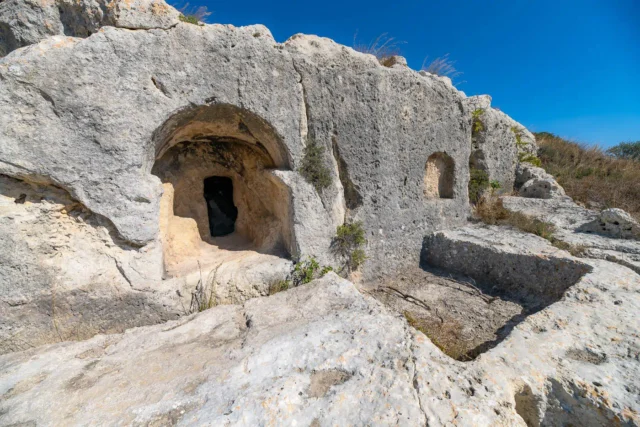
Vakiotes Acropolis
The Vakiotes Acropolis, located east of Sokaras village near Velouli and Apoini in Crete, is an archaeological site with dwellings and tombs carved into the rock. This unique construction, along with finds like wine presses and a Roman-era tomb, suggests a long period of occupation from the Geometric period to the Turkish era. The site's name and evidence of wine production may link it to the god Bacchus. Archaeological investigations have uncovered a tomb with silver denarii from the reigns of Roman emperors Vespasian, Trajan, and Domitian. The surrounding landscape also features remnants of a church and an old windmill. Declared a protected archaeological site in 2001, Vakiotes Acropolis offers a glimpse into ancient construction techniques and daily life.
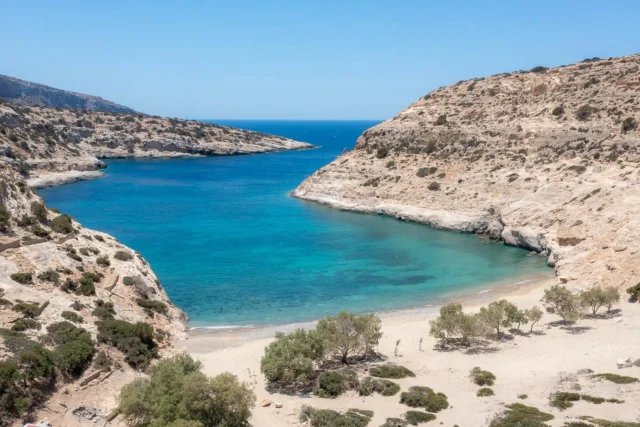
Vathy
Vathy Beach, a secluded haven on Crete's southern coast, is located 79 kilometers southwest of Heraklion and 17 kilometers south of Sivas, near Cape Lithino. The beach, nestled at the end of a gorge carved by the Vathy stream, is surrounded by towering cliffs that create a lagoon-like setting. Historically, it was a pirate hideaway and a hermitage for monks from the Odigitria Monastery. The surrounding cliffs feature natural alcoves and shelters built by locals from Gergeri village who brought their flocks here to overwinter. The beach is generally calm, except during westerly winds, and has a sandy seabed with some rocks. It offers a tranquil escape, with few tamarisk trees for shade and no amenities. To reach Vathy, drive from Sivas to the Odigitria Monastery, turn right onto a dirt road heading west, and continue for about 10 kilometers. Despite its remote location, the beach can get crowded in August.
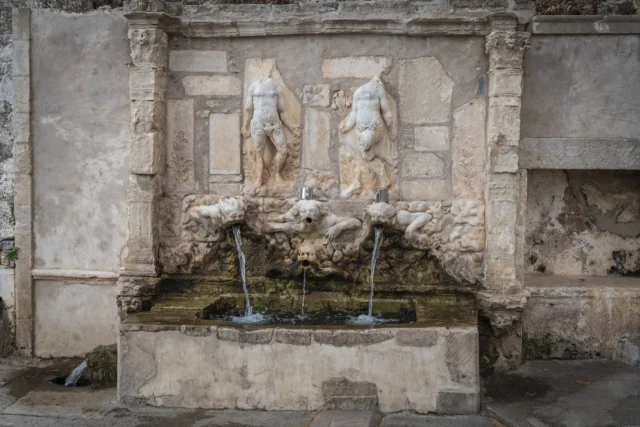
Vrontisi monastery
Moni Vrontisiou, a historic monastery in the Psiloritis Mountains of Crete, dates back to the 9th century. Dedicated to Saint Anthony and the Touching of Thomas, it is known for its architecture and frescoes. The monastery played a role in the Cretan struggle for independence, serving as a refuge for monks and a hub for revolutionary activities. Its fortified walls, two-story main building, and bell tower stand as a testament to its history. The 15th-century marble fountain at the entrance is a highlight, featuring intricate carvings. The main church houses surviving frescoes from the 14th century. Moni Vrontisiou is located 49 kilometers southwest of Heraklion and is open daily from 8:00 AM to 5:00 PM with free admission.

